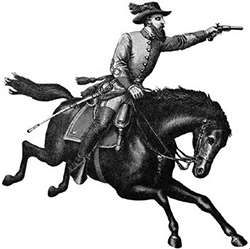
Please send all Checks and Money orders to :
Dave Taylor P.O. Box 87 Sylvania, OH 43560
419-842-1863
Click Here to E-mail Us!
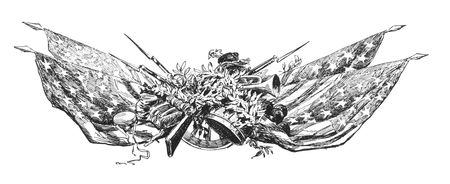

13 05

13-05-01 … Extra Fine M-1851 Colt Navy Revolver:
A seriously fine example of the famous Navy Colt. 100% original, 100% complete, mechanically perfect, and truly beautiful. The barrel retains 35% to 40% original blue finish, the cylinder retains 20% to 25%. The frame, rammer, and hammer retain 35% to 40% original factory case color. All serial numbers match 54,845. The cylinder retains 98% of the roll engraved naval battle scene. Grips are excellent. Back strap, butt strap, and trigger guard retain generous traces of the original silver plate. This gun is perfect to display with US or Confederate officers or cavalry effects. It was manufactured in 1856 based on the serial number records. A fine tight example that you will be proud to display.
One of the better navies I have found in recent months
… $4,500.00 SOLD
Click Here to E-mail Us!
Call us @ 419-842-1863
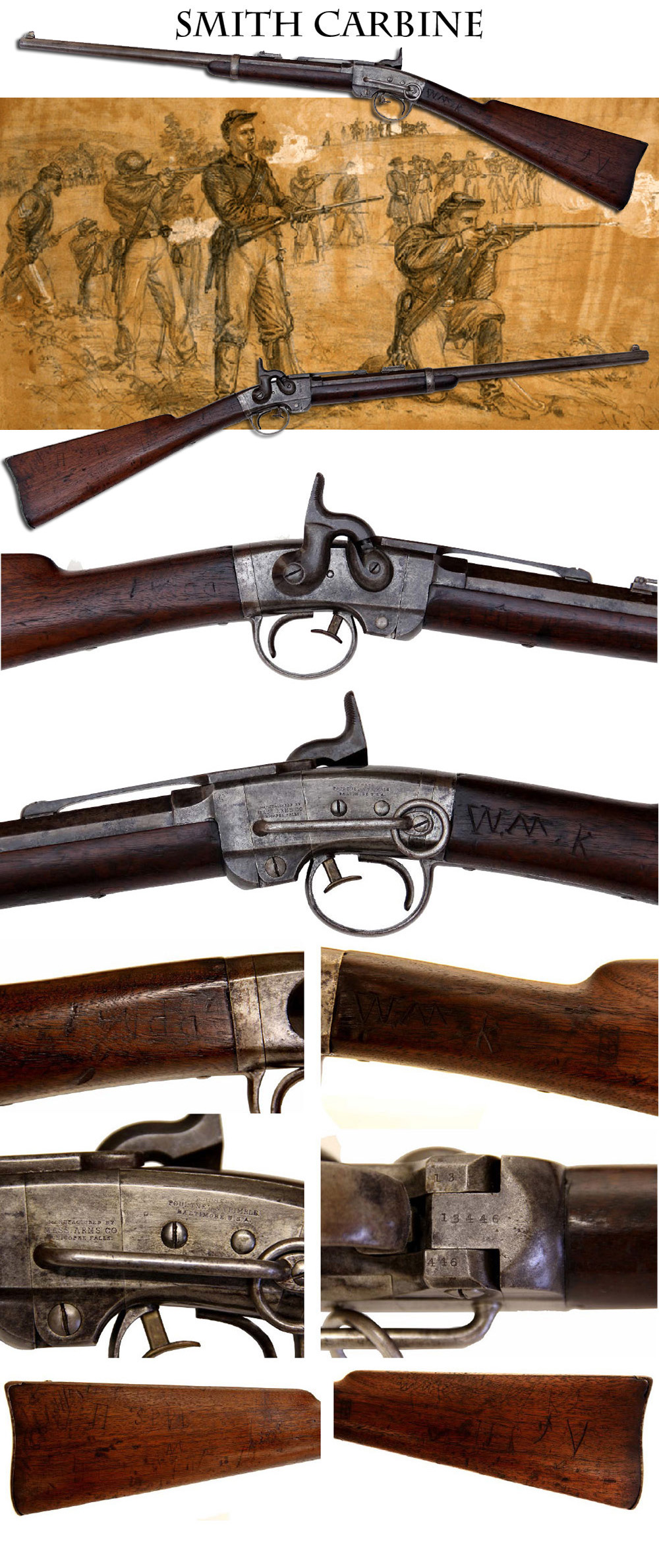
13-05-02 … Smith Carbine … Good field-used example of this popular carbine,
serial number 13446. About 30,000 of these were made from 1861-65 and the US government bought the lion�s share. Breech loading .50 caliber percussion, firing a foil or rubber cased cartridge. Cavalry units such as the 1st Connecticut, the 11th Illinois, and the 7th Pennsylvania carried Smiths. This one has a tight wood to metal fit, sling bar and ring in place, iron mounts. Barrel smooth showing gray mixed with faded blue, gray and very faded case on the receiver, smooth and no pitting. Matching wood on the butt and forestock. Several sets of initials lightly carved in the butt stock on both sides. More deeply carved at the offside wrist just forward of the visible cartouche is W.M. followed by K, either the first initial of a last name or a company letter. Bears Mass. Arms and Poultney & Trimble agent markings on the receiver reverse side. Good bolster and nipple, not battered down, crisp action in unlocking the breech for loading. From the serial number, this would be about in the middle of production and more liable to have seen use than a high numbered gun. 100% original 100% complete, mechanically perfect. VG to near fine condition
… $1,495.00 SOLD
Click Here to E-mail Us!
Call us @ 419-842-1863

13-05-03 … Inscribed and Researchable Mexican War 1847 Dated Model 1842 Pistol by Aston.
The inscriptions on this pistol lend themselves to some interesting possibilities. The back strap has a crudely engraved name HENLY with a very folky reversed N. The trigger guard is nicely, though not professionally, engraved 38 surrounded by a vine and flower motif and the top of the barrel band has a similarly engraved company letter B, a Roman numeral VI is found at the top of the back strap, very much suggesting the gun was owned by someone in Company B of a regiment numbered 6 with a rack number of 38, or vice versa, though most likely the former as the soldier name Henly would likely bear a company rack number in the 30s or 40s, and a low rack number of 6 would likely be assigned a soldier with surname beginning with A,B, or C. Forward of the trigger guard in the wood is a V stamp and then a scratched in URS or URZ. Due to the fact that this is a Mexican War dated gun, it is possible that the unit markings reflect Zachary Taylors own 6th US Infantry regiment. I do not have access to the enlisted roster to see if there is a soldier named Henly in company B. Taking another path If we assume the inscriptions were put on during the Civil War we would also assume that such a gun would have most likely have been carried by a Confederate, the north having revolvers to issue mounted troops. My research of the civilwardata.com site reveals the following Confederates named Henly serving in a 6th or 38th Regiment:
Darby Henly 38th Mississippi Cavalry
David Henly 6th Georgia Infantry
John T Henly 6th Missouri Infantry
Joseph Henly 6th Georgia cavalry
T J 6th Henly Alabama Infantry
My guess here would be the 6th Georgia Cavalry would make the most sense. I have done only the most cursory research, and believe that a thorough search of all records will likely reveal the answer. As for the gun itself US / H. Aston and Middtn/Conn/1847 lockplate markings with a matching 1847 date on breechplug tang. Intended to replace the m1836 flint pistols, these .54 caliber percussion weapons had roughly the same dimensions, but with some improvements. They were intended to be carried in pairs in saddle holsters at the pommel of the saddle by officers and enlistedmen and many were still in service at the beginning of the Civil War in state units and with officers. Most sat in an armory but this one shows light field use and some personalized touches showing it was actually carried. Rammer assembly in place and functional, as is the lock. Wood smooth with decent edges, one slight line to rear of the lock on the wrist, but still solid. Barrel gray with dark spots, brass light, but will tone down. Lockplate slightly bluer gray with some small dings and salt and pepper near back edge, but with sharp bolster and nipple. Some corrosion on top of breech from firing. Two very legible cartouches in the wood, JH on left barrel flat, US/GWH/P on barrel, the left of the U and the top of the P a bit light and in area of firing corrosion from the primers as is the barrel date. A great personalized weapon that will be great fun to research
… $1,450.00 SOLD
Click Here to E-mail Us!
Call us @ 419-842-1863
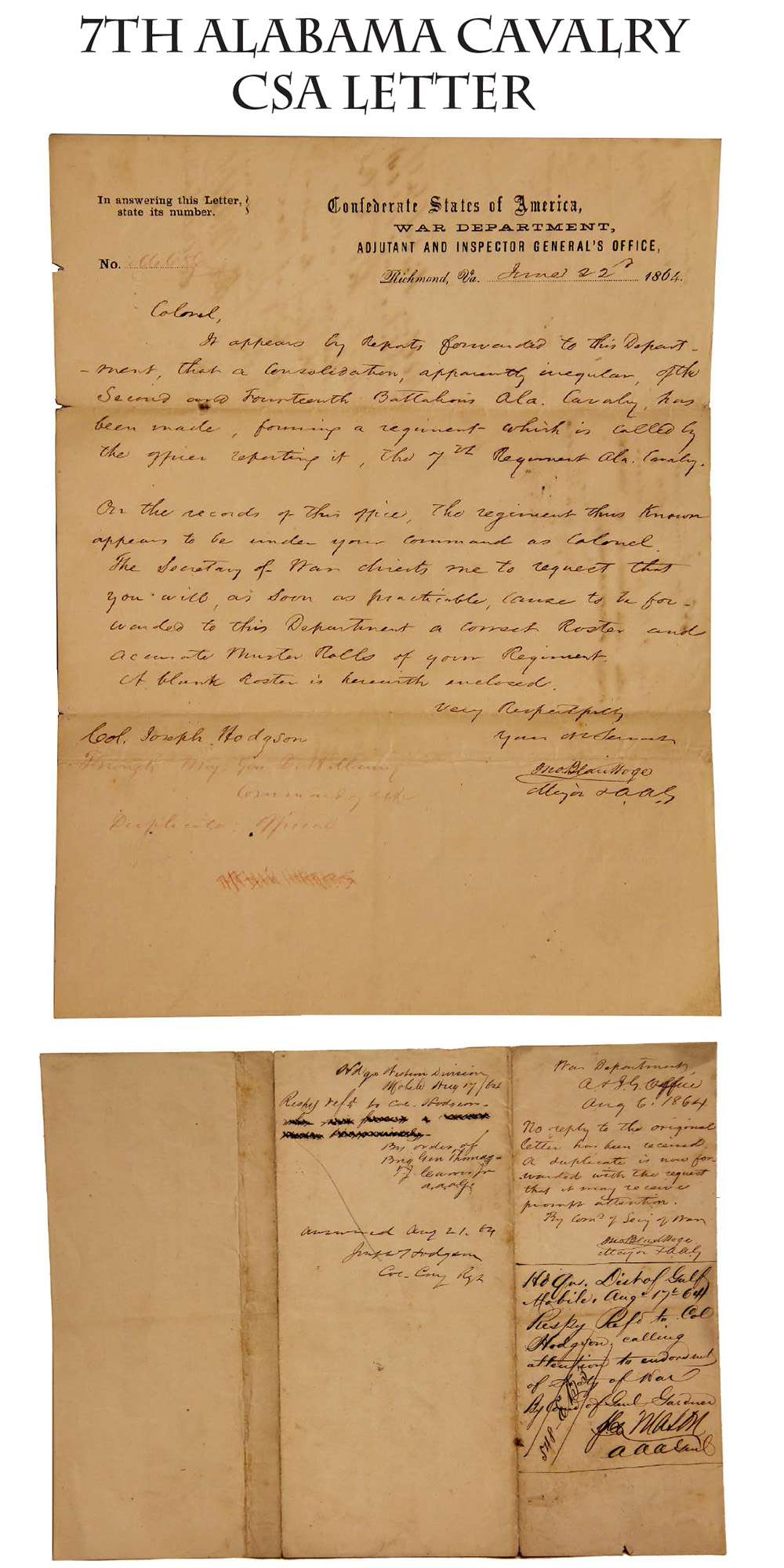
13-05-04 … They rode with Forrest!
Letter to Colonel Joseph Hodgson 7th Alabama Cavalry from the CS War Department.
As the war went on the Confederacy was forced to form many composite units by consolidation. Here is an official letter from the Confederate central government to an Alabama officer requesting clarification on his unit’s composition in 1864, on Official Confederate States of America War Department stationary from the Adjutant and Inspector General’s office in Richmond, dated June 22, 1864.
Colonel,
It appears by Reports forwarded to this Department, that a Consolidation, apparently irregular, of the Second and Fourteenth Battalions Ala. Cavalry, has been made, forming a regiment which is called by the officer reporting it, the 7th Regiment Ala. Cavalry. On the records of this office, the regiment thus known appears to be under your command as Colonel. The Secretary of War directs me to request that you will, as soon as practicable, cause to be forwarded to this Department a correct Roster and accurate Muster rolls of your Regiment. A blank roster is herewith enclosed.
Very Respectfully, Your obt. Servant,
Jno. Blair Hoge (??)
Major & A.A.S.
Docketed on reverse that no response had been received by Aug. 6 and a duplicate was sent out, then notes that a response was received Aug. 17.
The 7th Alabama was organized in July, 1863, as part of Clanton’s brigade, and served for more than a year in Quarles’, Clanton’s, Page’s, Patton’s and Thomas’ brigades, in the vicinity of Pensacola and the bay forts. I don’t find indications of the 2nd Alabama Battalion of Cavalry being taken into it, but the 14th does seem to have supplied some men. In the fall of 1864, the Seventh reported to General Forrest at Corinth, and took part in the raid on Johnsonville and the fighting as Hood moved toward Nashville. According to CS records, “it suffered severely at this time, especially in the night attack on Brentwood. The regiment, after recruiting, joined General Buford at Montevallo in March, 1865; confronted Wilson’s corps from Benton to Girard, and took part in the last fighting of the war, surrendering at Gainesville, May 14, 1865. Col. Joseph Hodgson led the regiment throughout the war, though detachments were at various times commanded with brilliant success by Maj. Turner Clanton, Jr., Captain Ledyard, and others.”
Anything related to western theatre Confederate cavalry is unusual.
This also has a nice association with one of the most famous cavalry leaders of the war
… $225.00 SOLD
Click Here to E-mail Us!
Call us @ 419-842-1863
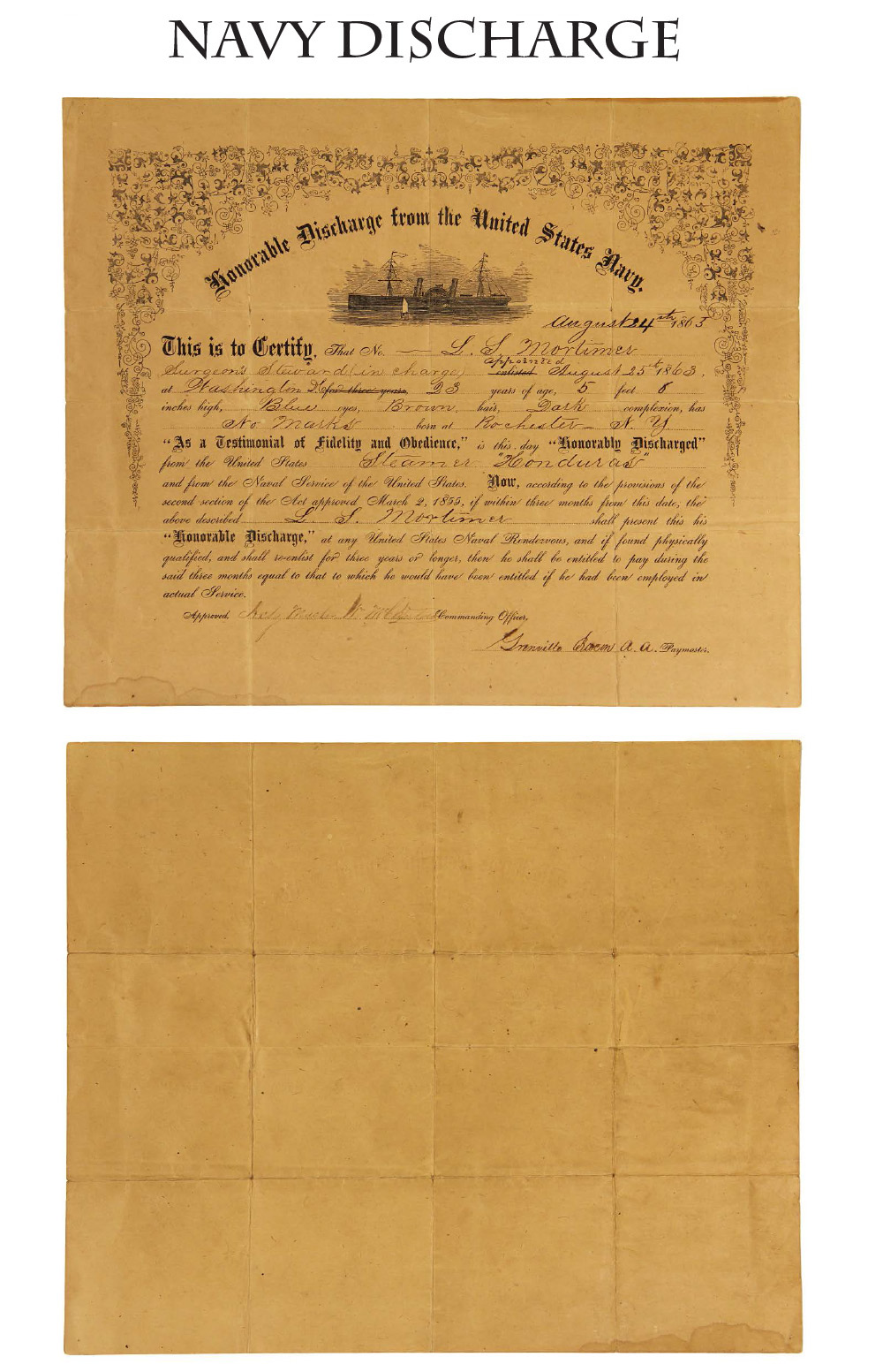
13-05-05 … Exceedingly Rare USN Sailor’s Discharge:
When I saw this at an antique show three weeks ago I racked my brain trying to recall the last time I owned one. The answer is that I only recall owning two or three of these documents in the last forty years! So I bought this one. The number of sailors in the 1860s were but a tiny fraction the number of army soldiers in the Civil War and consequently Navy items are correspondingly much more rare. Here is a scarce US Navy discharge certificate, the equivalent of the army “eagle discharge”. Nice floral border, a steam warship at top center with the words, “Honorable Discharge from the United States Navy” in an arc over it. This one is dated August 24th, 1865, and given to L.S. Mortimer the Surgeon’s Steward, who was appointed August 25, 1863 in Washington and was being discharged from the Steamer “Honduras.” Signed at bottom by his commanding officer and the paymaster. Fold lines, as Mortimer obviously carried it in his pocket, but no separation lines. Very minor water stain lower left margin. The Honduras was a side wheel steamer built in New York in 1861 and in 1863 purchased and commissioned in the US Navy as a supply boat and dispatch steamer. She did see her share of action though: on Oct. 15, 1863, she captured a blockade runner in the Gulf of Mexico, and shared the honor of another capture in May. She also took part in amphibious operations, landing troops at the mouth of the Caloosahatchie River in January, 1864, and at Tampa in May, and took part in a joint expedition to the St. Marks River in Florida in February-March, 1865. She was decommissioned in August, 1865. Mortimer’s service seems thus to correspond with that ship’s service precisely.
A fine, rare, and handsome document
… $350.00 SOLD
Click Here to E-mail Us!
Call us @ 419-842-1863

13-05-06 … 109th Pennsylvania – Chancellorsville Wounded – Soldiers Dog Tag and related …
Very scarce and highly desirable pewter identification disc with McClellan – Antietam motif on the obverse. Stamped on the reverse to John McGrath Co. C 109th Penna. Vols. with a Battle Honor and date of the battle. McGrath served from March of 1862 at least through early 1864 and was severely wounded at Chancellorsville in the elbow. He was eventually transferred to the VRC and discharged due to wounds. At Chancellorsville the 109th was brigaded with and fought with The Pennsylvania Bucktails. Following is the Chancellorsville after action report of Capt. John Young, Jr. … On the morning of May 1, we were ordered in line, and marched up the Plank road from the brick house where general Hooker had established his headquarters … the first and second companies were deployed as skirmishers through a dense wood, which was filled with newly made rifle-pits, but were then deserted. We advanced about 2 miles, when we met a body of the enemy’s cavalry. They proved to be too powerful for us, when we were ordered to rally on the reserve in the road. We returned to the regiment in good order, bringing in 1 prisoner. In about an hour the second company was again thrown out as skirmishers through the same wood. Having advanced about half a mile, the enemy was observed advancing in line on our right flank with a large force of infantry and artillery. We then received the order to fall back on the regiment, which was done in good order. We then fell back, and occupied our old camping-ground of the night previous. About dusk two companies–the first and fourth–were thrown out in front of the brigade as skirmishers, where they remained until midnight, when they were relieved by the third company. On the morning of the 2d, we took our old position in the rear of the entrenchments. About 1 o’clock we were ordered out on a road on the left of the Plank road, and thrown out to the right and left of the road, where we encountered the enemy, and lost 1 man killed and 11 wounded. We then fell back, and occupied the entrenchments left vacant by the Third Brigade where we remained that night under a straggling fire from the enemy’s sharpshooters in the front, and an enfilading fire from the enemy’s batteries. On the morning of the 3d … About 7 o’clock, Col. H. J. Strainrook, who was on the level ground in rear of the entrenchments , rose to give an order to the men on the right, when he was struck from the front by a rebel sharpshooter concealed in some neighboring tree-top. He was immediately taken from the field. On the way to the hospital he was struck by a Minie ball, which broke his right arm, and entered his right lung, from the effects of which he died fifteen minutes afterward. The enemy getting the range of guns, the shells fell thick and fast, some in and some on top of the entrenchments. One exploded in a squad of the first company, killing 1 and wounding 2. We lay here some time, when,receiving the order, we fell back in good order to the Plank road, where we were met by Gen. Kane and the rest of the brigade… We then marched to a piece of woods, where we halted, and some fires being built, the enemy, observing the smoke, commenced shelling us quite rapidly. We were ordered in line again, and marched farther to the right, out of range of the enemy’s shells, End of report. This dog tag was undoubtedly worn by McGrath at Chancellorsville based on the fact that he obtained it in late 1862 (the only battle honor on the disc is Cedar Mountain on 8/9/62). Accompanied by the illustrated paper items
… $975.00 SOLD
Click Here to E-mail Us!
Call us @ 419-842-1863
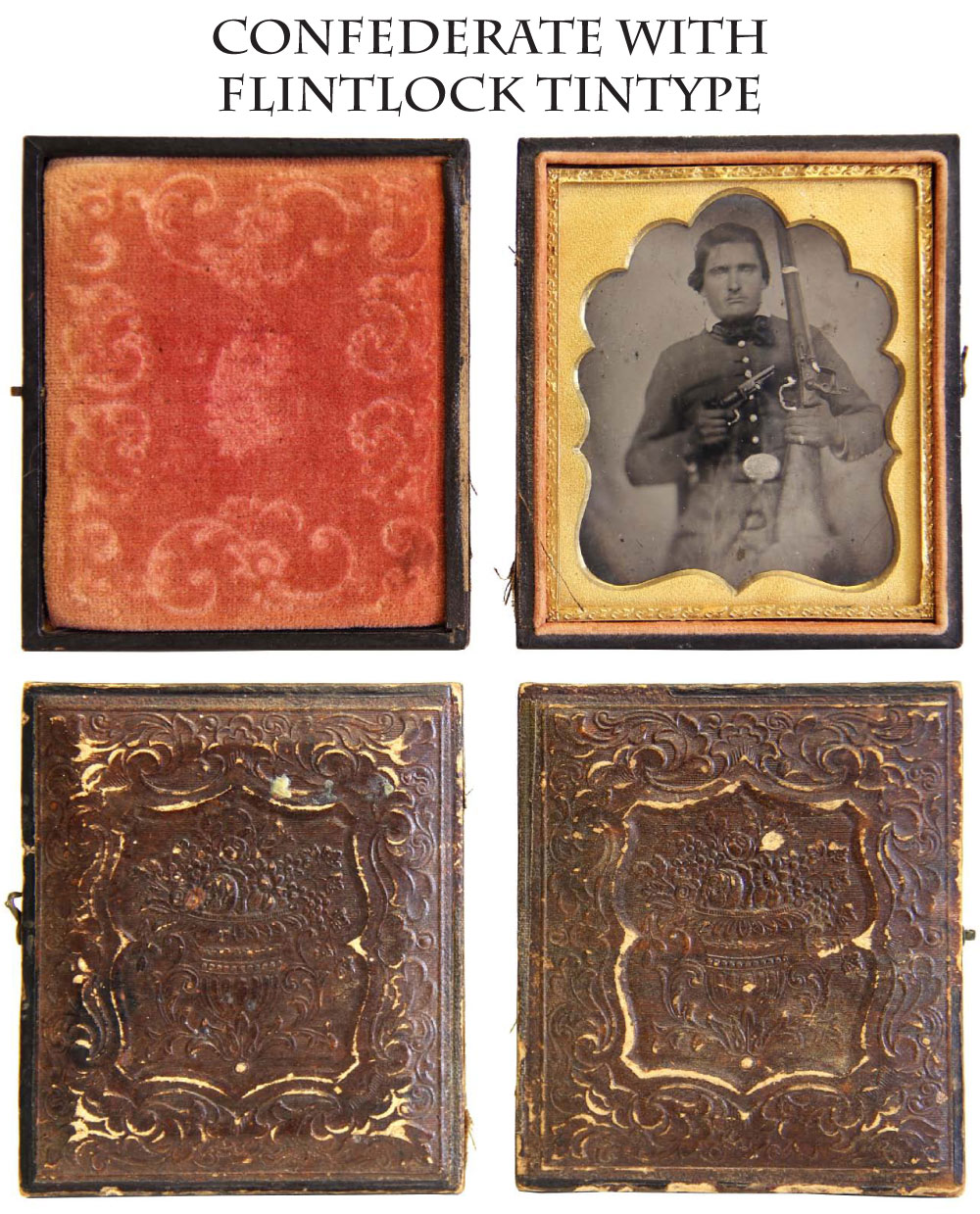
13-05-07 … Dramatic Confederate Sixth-Plate Ambrotype of a Double-Armed Confederate sporting a revolver and a flintlock musket!
This is the typical early war Southern volunteer posed just the way you want to find him. This no-doubt-about-it Johnny Reb wears a gray frock coat and a large oval waist belt plate, has carefully combed his hair and arranged his necktie and now proudly displays his lethal hardware to the folks back home. The flintlock musket is quite a rarity to find in wartime images. The photographer tinted some metallic parts, and the flavor of the image comes through great. This a top-notch example of an early war southern volunteer, taken at the time when regiments were so short of arms they took the field with outmoded flintlock military arms, fowling pieces, and shotguns. Such weapons were carried until better ones could be obtained from the ordnance department or picked up on the battlefield. The revolver is probably a gift from a loved one for personal defense, typical of the arms brought into early war army camps from home and showing that he meant business. Slightly soft focus on the bottom half of the image, the cameramen often had problems adjusting focal length and this artist focused on the chest-up area and failed to capture the lower section clearly. Typical period leatherette or paper-mache case, separated at hinge, but with pad still in place. This would be a great addition to a Confederate collection or a general Civil War display showing precisely how the early war volunteers looked when they marched off to fight
… $895.00 SOLD
Click Here to E-mail Us!
Call us @ 419-842-1863
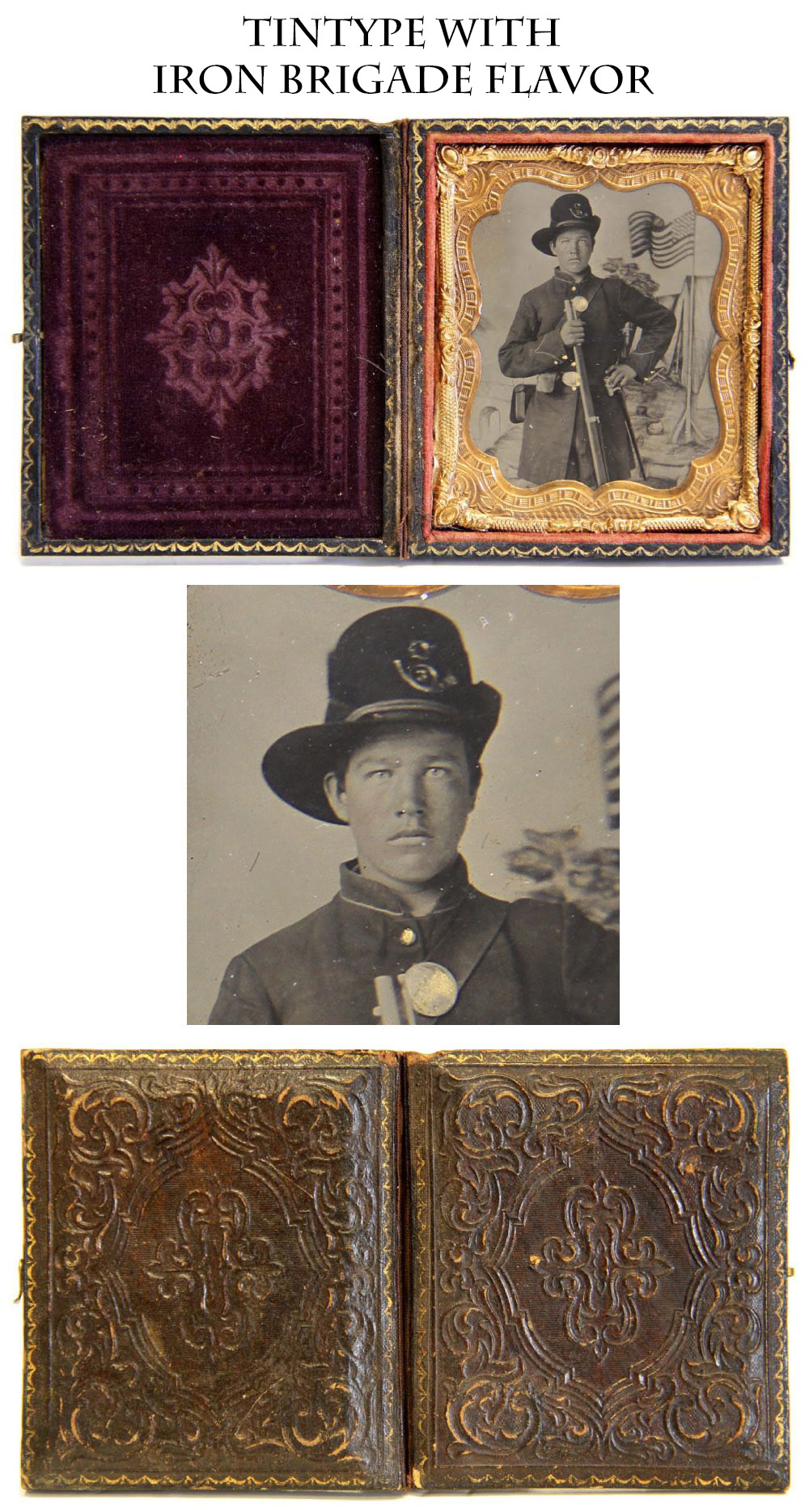
13-05-08 … Quarter Plate Tintype:World-class 2/3 standing armed Yankee
… an image with excellent clarity, contrast, composition and subject. Wonderful painted camp scene backdrop with an American flag flying right next to the subject’s head. Our guy is topped out and knew how to strike a pose! … Serious young man posed in his infantry frock, shown from the knees up, standing with one hand on hip, the other holding his rifle musket. His cartridge box, cap box, bayonet in scabbard, and both waist belt and box sling with both plates visible. He wears the regulation army dress hat, a.k.a. the Hardee hat, showing its hat cord and feather, and infantry bugle together with what looks like a letter “D” over it and what appears to be a “3” within the loop of the horn insignia. The soldier has made an effort to correct for the reversing of the tintype by switching around his equipment so that it appears on the correct side from the viewer’s perspective, but the buttoning of the coat shows that it is reversed as does the hat insignia- I also show detail of his head and hat mirror reversed & corrected by computer to clarify the insignia. Buttons and plates gilded … overall excellent detail and clarity. Complete with mat, frame, and glass, purple facing pad, leatherette case with impressed floral motif.
Hinge separated. No proof of what state he came from, but that pose, uniform, and the Hardee hat makes him look like part of the Iron Brigade … though the “3” on his hat would not conform to the brigade. Wonderfully exciting image
… $495.00 SOLD
Click Here to E-mail Us!
Call us @ 419-842-1863
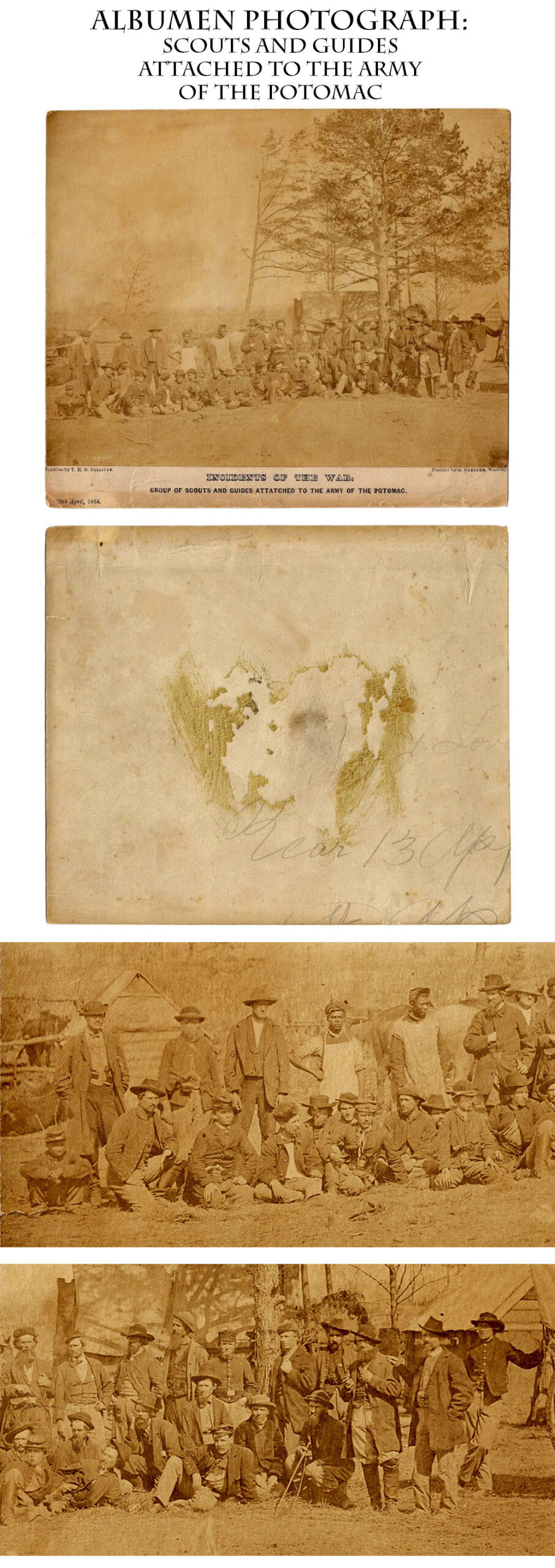
13-05-09 … Grants Pathfinders! Superb Photograph! Scouts and Guides of the Army of the Potomac,
photographed by Timothy O Sullivan in April 1864. This photo was taken just prior to the launching of Grants overland campaign that eventually terminated the war. This is the group of daredevils who led the army into enemy territory. About 35 men are shown casually standing, kneeling, and sitting on the ground, most in a uniform of sorts, but a number in civilian garb, and quite a few sporting revolvers jammed in their belts. Winter camp huts stand in the background, and two Black men with smocks or aprons are plainly present, probably serving as cooks or farriers, and likely recently freed local slaves who knew the area where they lived. Operating individually and in small groups as scouts and spies, these men were subject to ambush by enemy patrols and death by hanging if caught in civilian clothes or the Confederate uniforms they sometimes donned to scout and gather intelligence. It took a lot of courage to fight in line of battle, but it took a special kind of nerve to perform the tasks of scouts and guides. Top and sides of the mount trimmed to the albumen, but not affecting the image. Size roughly 8 x 10 inches. Lower margin of mount stamped with O Sullivan and Alexander Gardner photographer information, April 1864 date, and formal title from Incidents of the War series of their photographs. Minor stains and pencil marks on the reverse.
Slight age toning … One heck of an image with wonderful subject matter
… $550.00 SOLD
Click Here to E-mail Us!
Call us @ 419-842-1863
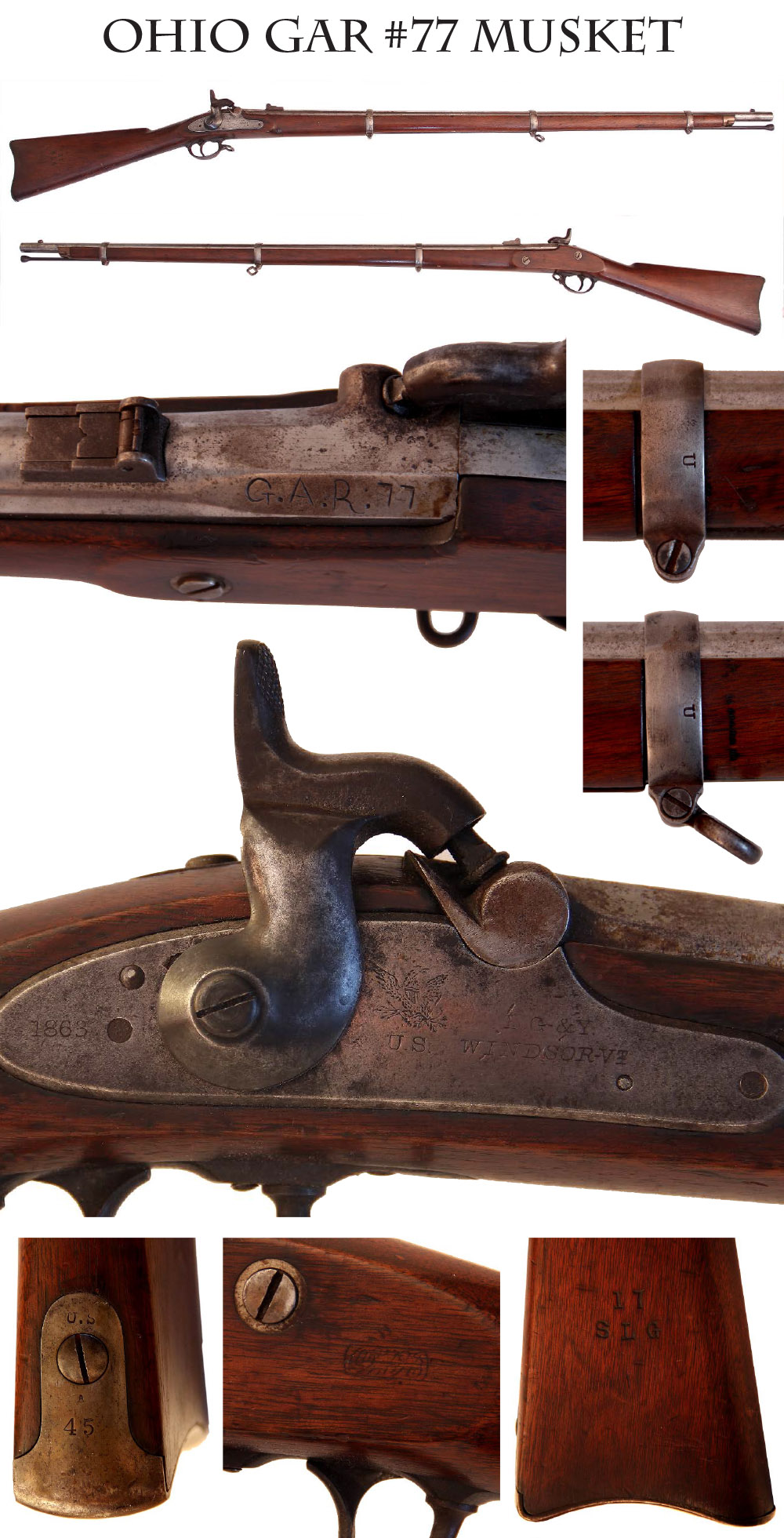
13-05-10 … 13-02-67 – Ohio Soldiers Musket w/ GAR Post Markings:
A VG example of the Special Model 1861 musket made and marked by Lamson Goodnow and Yale. 100% original, 100% complete, mechanically perfect, all markings legible except for the VP & eagle-head which has been replaced with a marking by G.A.R. Post 77. Nice clear cartouche in wood. Matched dates of 1863 lock and barrel. Also marked on the gun stock is 17 over S.L.G. These are likely the soldiers initials and his company number or post member number. Butt plate also stamped 45 meaning unknown. Probably a rack number.
This gun surfaced in central Ohio and was brought to me at a meeting of The Ohio Gun Collectors Association. GAR Post 77 was the Ben Butterfield Post in Lancaster, Ohio (Shermans home town). I will leave the heavy lifting on the research to you. If you can find a roster of the Butterfield GAR post and can match the initials on the gun to a unique member of that post — then you can extract the history with a reasonable degree of certainty.
Good old Civil War musket and one with a charming GAR association.
… $1,395.00 SOLD
Click Here to E-mail Us!
Call us @ 419-842-1863
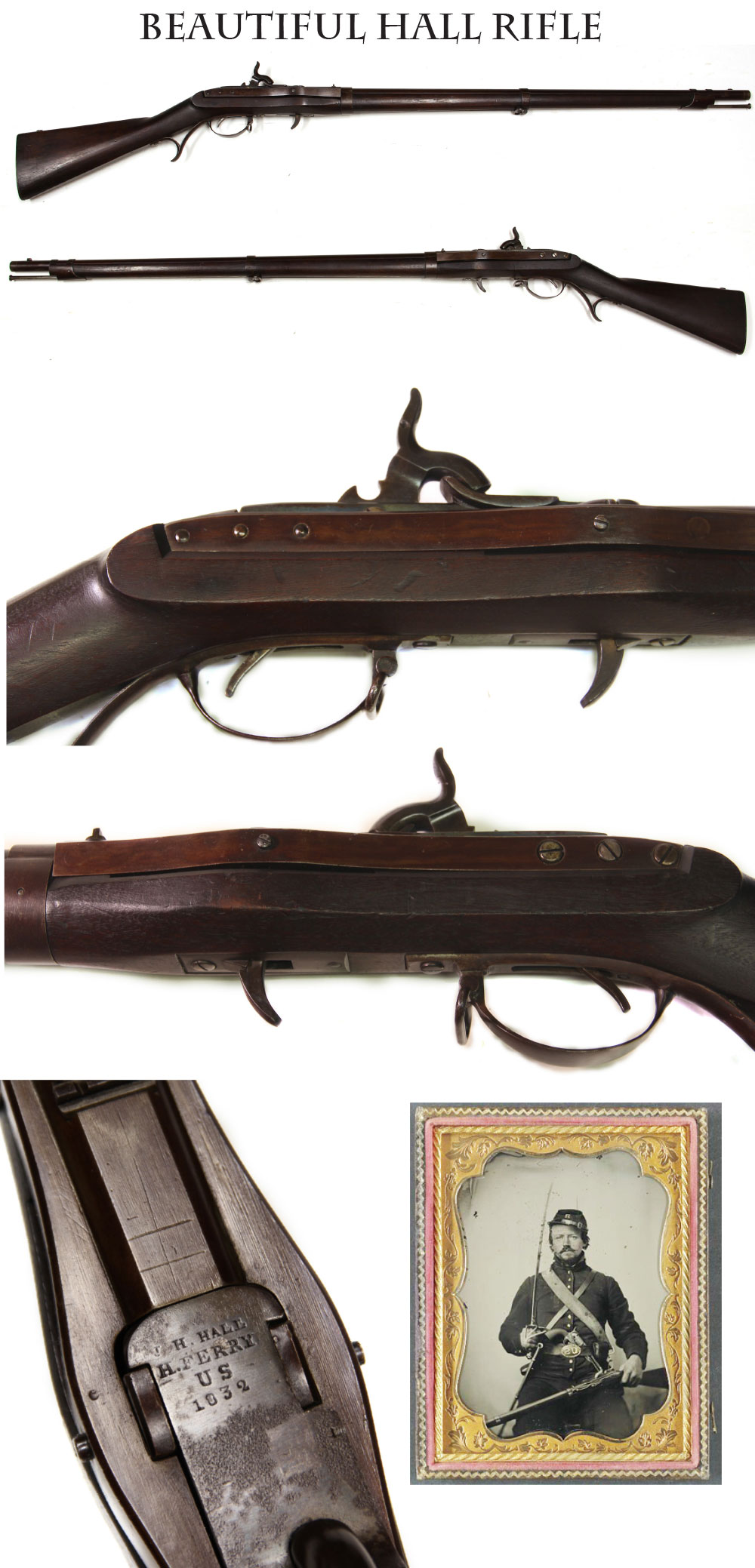
13-05-11 … 12-10-19 – Investment Grade Model 1819 Hall Rifle
Converted to Percussion in NRA “Excellent” Condition: Extremely fine condition retaining 95% original lacquer brown finish on the barrel and frame, and having “minty” stock with very sharp edges and showing only minimal handling wear. Slight wear on the finish near the muzzle. A top notch example in anyone’s book. The breech block is stamped “J.H. Hall / H. Ferry / U.S. / 1832” showing this to be part of the second production run of these interesting breech loading rifles. 52 caliber with an excellent bore.
You would be hard pressed to find a better example
… $2,950.00
description here
Click Here to E-mail Us!
Call us @ 419-842-1863

13-05-12 … 12-11-12 – This canteen is inscribed several times.
“Edward D. Dwyer Saratoga ????” “Edward D. Dwyer Co??????” (appears to be a long word). Also inscribed along the outer edge “Michael Dwyer of West Hadly”. Pretty easy to find the area the men resided in… Hadley and Saratoga are in Saratoga county New York. Edward D. Dwyer whose name is in the center of both sides of the canteen is listed in the records as serving from Saratoga and having served in the 77th New York being wounded at Spotsylvania. Michael is not as easily pinned down, though deep archives research would likely tell the story. Edward appears clearly to have been the war time owner of the canteen with his name in the center of both sides of the canteen. I assume Michael is his brother or son. Nice canteen just missing bottom bracket
… $295.00 SOLD
Click Here to E-mail Us!
Call us @ 419-842-1863
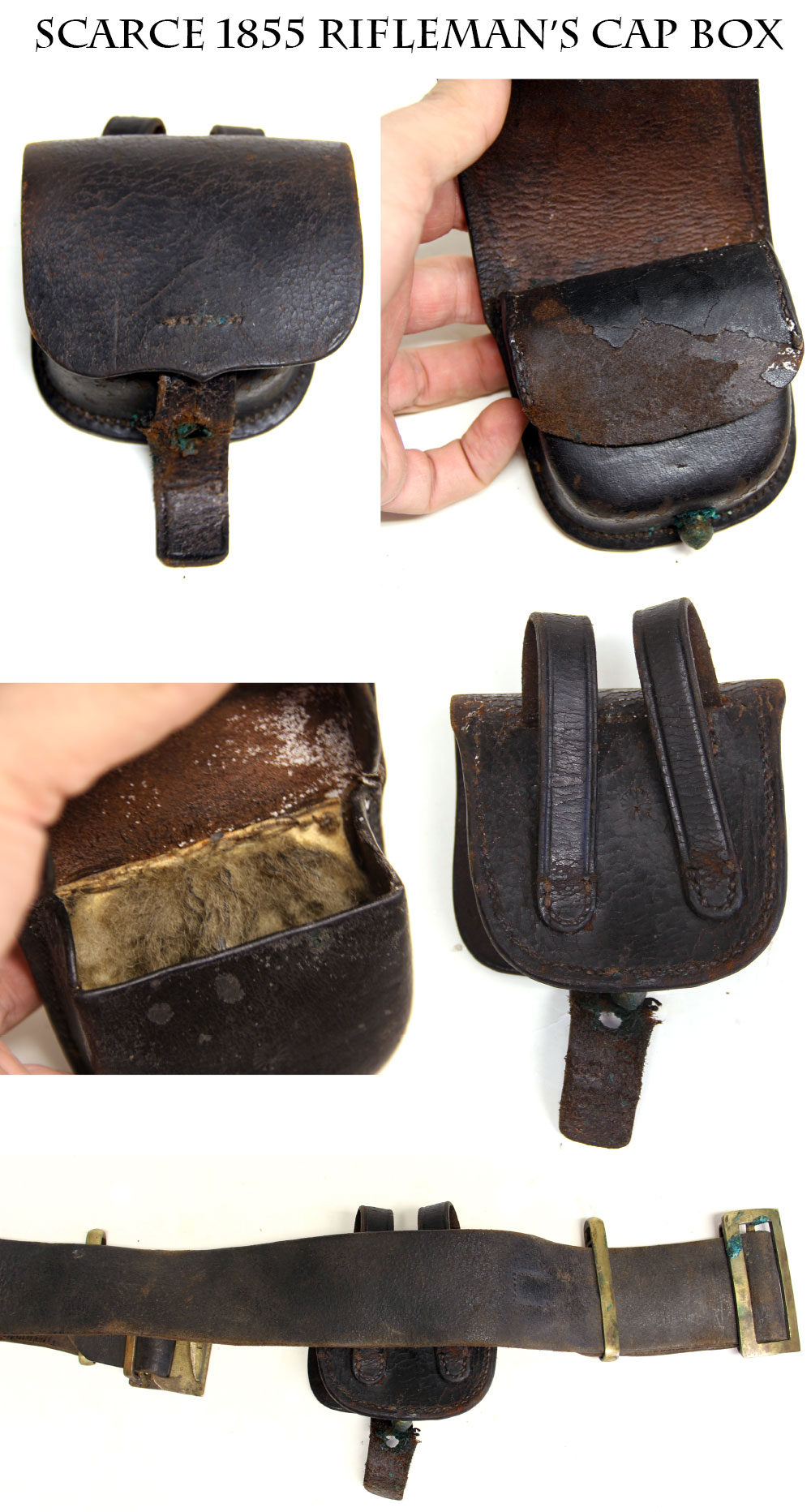
13-05-13 … 12-12-03 – Scarce 1855 Riflemans Cap Box:
This has the two-piece cover that uses a full outer flap and separately attached latch tab secured by a single line of stitching. These are generally recognized as the early-war and pre-war versions of the percussion cap box. What sets this box well apart of standard cap boxes is the height of the belt loops. These loops are extra tall for the purpose of allowing use with the ultra wide 1855 riflemans belts. The 1855 riflemans waistbelt was 2.2 to 2.4 inches wide and the loops on this cap box are intended for that belt. Both loops and latch tab have lightly incised border lines. The latch tab has three small stitches in it repairing a small tear, otherwise very solid and even has some of the wool lining still present. No markings visible, which is correct for an early arsenal produced piece. The 9th and 10th US Infantry were rifle-armed regiments and saw service in the west in the 1850s. This would be the type of cap box required for their belts. You will look long and hard to find another.
$175.00 SOLD
Click Here to E-mail Us!
Call us @ 419-842-1863
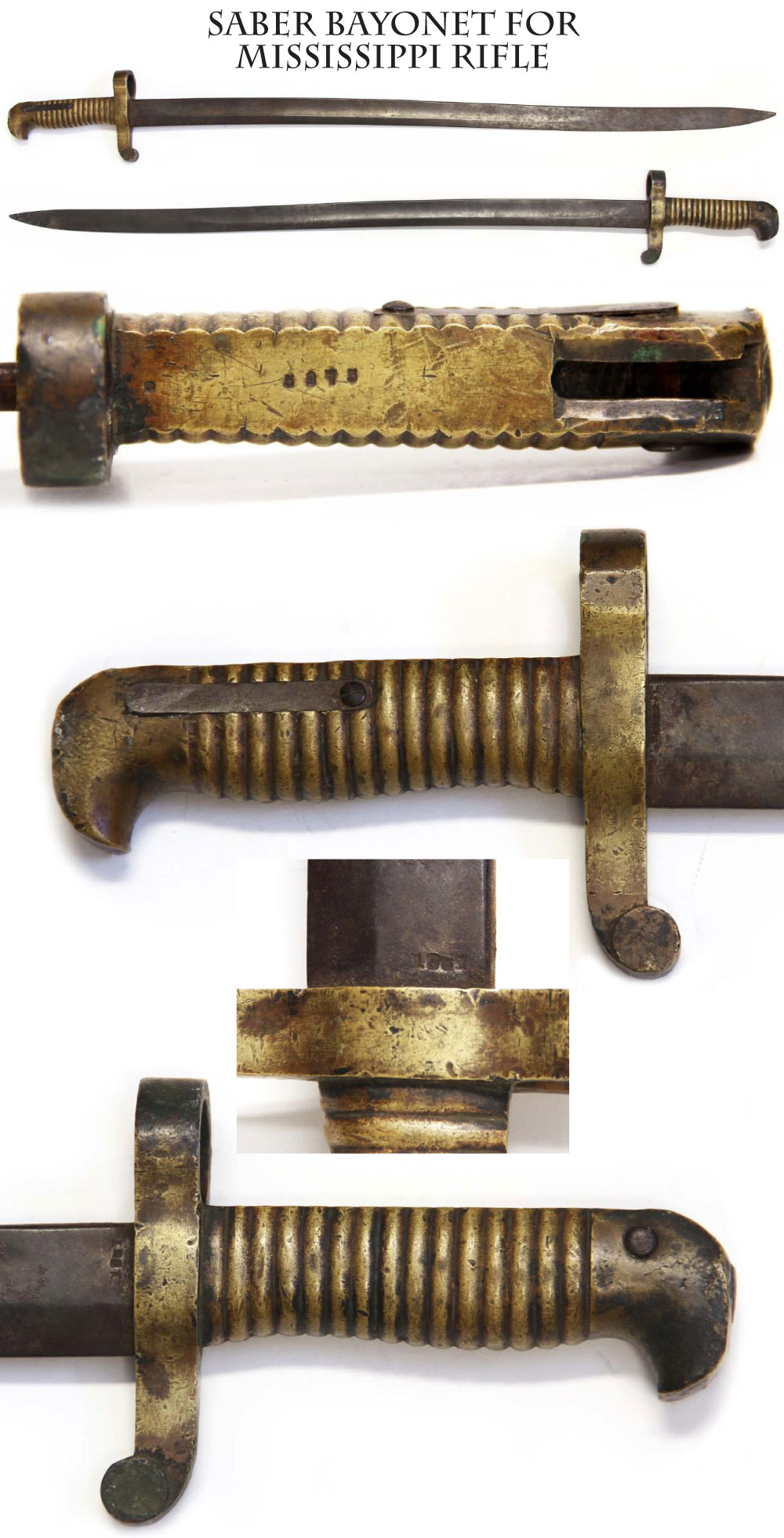
13-05-14 … 13-01-22 – Saber Bayonet for Colt Alteration of Mississippi Rifle:
A very good to fine example of the brass handle saber bayonet for the M1841 US Rifle aka Mississippi Rifle with the Colt factory alteration of adding rear sights and bayonet lugs.
Good solid example
$295.00 SOLD
Click Here to E-mail Us!
Call us @ 419-842-1863
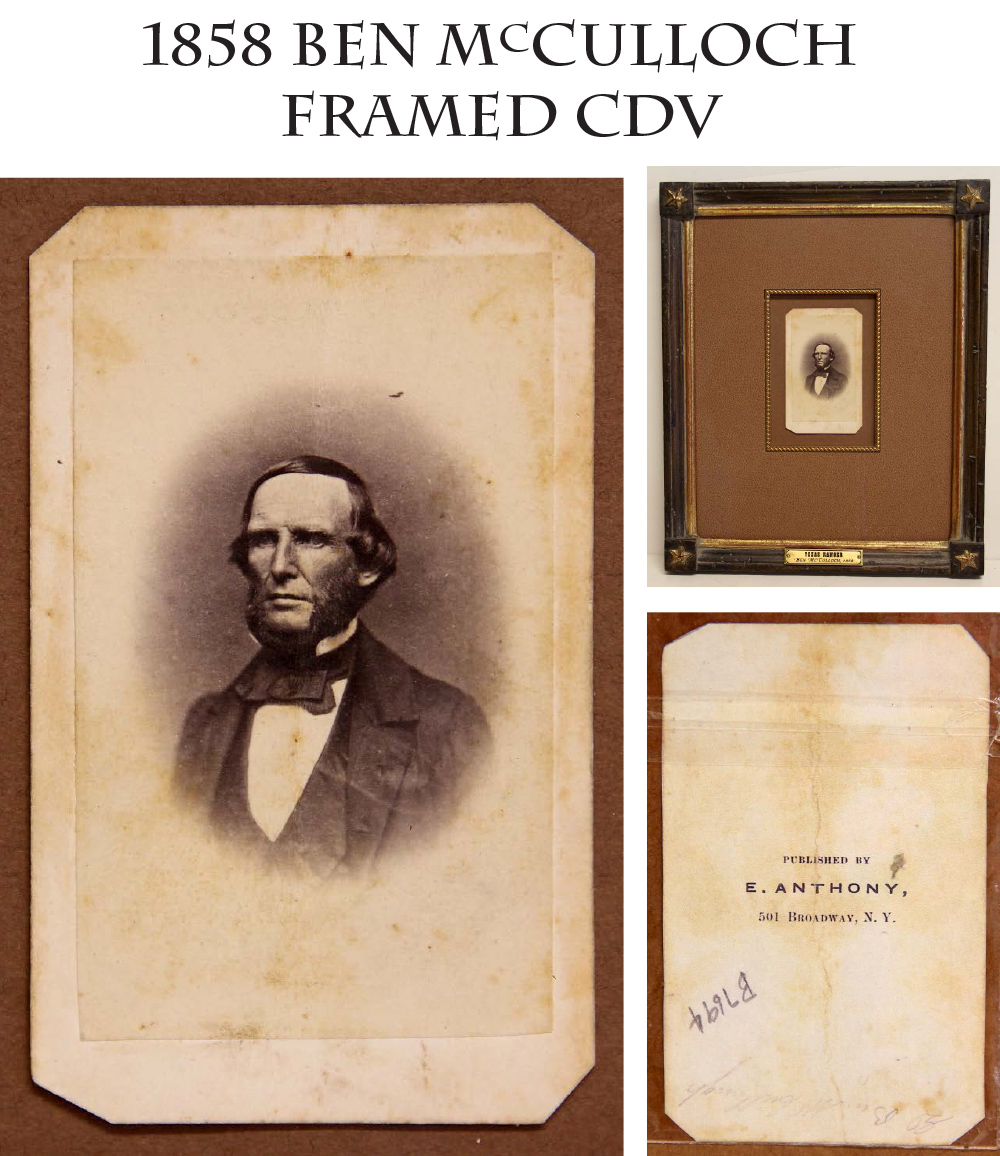
13-05-15 … Friend of Davy Crockett, Texas Ranger, US Marshall, and Confederate General:
Ben McCulloch, was one of the most colorful of all western figures. Born in Tennessee in 1811, McCulloch was a neighbor of Crockett and accompanied Davy to Texas in 1835, only escaping the latters fate at the Alamo because sickness delayed his arrival at San Antonio. He took his revenge at San Jacincto, commanding one of the Texan cannon, and later served in the cavalry, did some surveying work, and ended up in the Texas Rangers fighting Mexican raiders and Indians. During the Mexican War he served under Texas Jack Hays and led a scouting company of Texas Volunteers who did valuable work for Zachary Taylor at the Battles of Monterrey and Buena Vista in particular, after which he was promoted to Major. He went to California in the Gold Rush, and became sheriff of Sacramento, and eventually returned to Texas to be US Marshal for the Eastern District of Texas. When the state seceded in 1861, McCulloch was commissioned Colonel and seized all Federal property in San Antonio, forcing the evacuation of its garrison. Promoted to Brigadier General as a reward, he was given command of the Indian Territory and pieced together an Army of the West, with which in August, 1861, he defeated Nathaniel Lyon at Wilsons Creek, which gave the Confederacy control of the southwest portion of Missouri. On March 7, 1862, he commanded the Confederate right wing at the Battle of Pea Ridge. After an initial success, he did what he did best, and rode forward to scout the enemy positions, but was shot off his horse and killed. This CDV is professionally matted and framed showing both the face of the card and the reverse with its Anthony Back mark. This is an actual albumen photograph and not an albumen picture of a painting, or a lithograph. The previous owner spent great amounts of money on framing his documents and photos. Minor pencil notations on reverse. Frame with Texas stars in each corner and a name plate at bottom center with title TEXAS RANGER. A very significant figure in Texas and western history and the expansion of the U.S. An extremely rare photograph. I see there is one listed in an upcoming auction at Cowans estimated at $1000 to $1500 that does not have the clarity and contrast of ours. I will price this at what I believe is a very friendly price
… $650.00 SOLD
Click Here to E-mail Us!
Call us @ 419-842-1863

13-05-16 … A Real Yankee Greenback:
An actual piece of USA Civil War currency. Its tough to find these in anything but rag condition, and those command nearly two hundred dollars apiece. This one has a small tape repair to the right corner but is otherwise excellent. It preserves the vibrant reds, greens, and black colors and shows very little handling wear. A perfect display piece that will not set you back the better part of a thousand dollars. An extremely nice example of the one dollar 1862 note. This is what was received by the yankee soldier whenever the paymaster managed to catch up with the troops. He was paid thirteen per month at first and sixteen dollars at the end of the war. A key item for the Civil War soldier display to show what was used to make sutler purchases for pretty much everything other than hardtack, bacon, and coffee. This one priced just a fraction above what I paid
… $325.00 SOLD
Click Here to E-mail Us!
Call us @ 419-842-1863
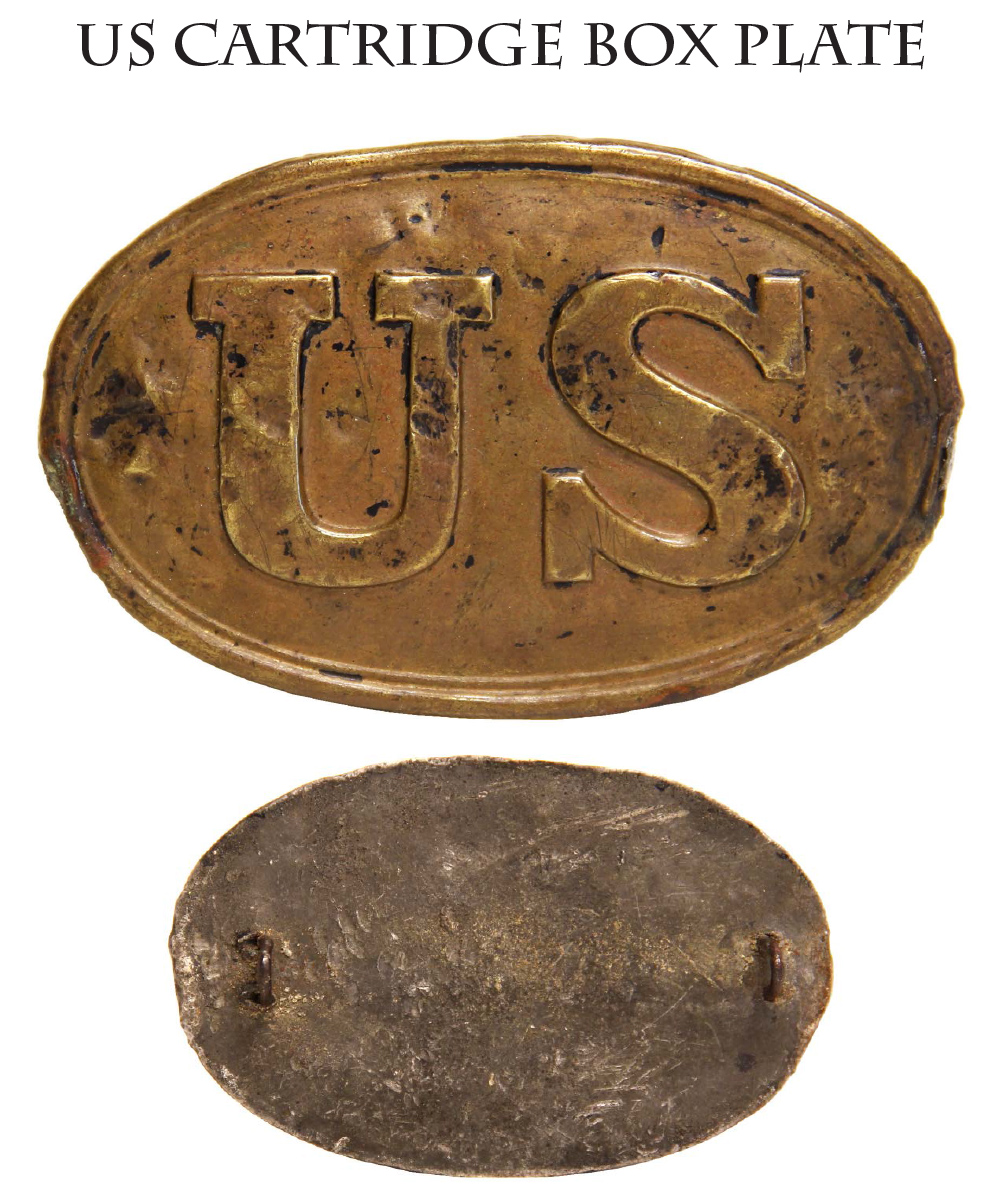
13-05-17 … US Infantry Cartridge Box Plate.
Regulation oval US plate struck in brass and filled with lead solder, with two loops on the reverse to secure it through the flap of the cartridge box. Some dings to the face and the edge, but an affordable example of the plate adopted by the army in 1839 to be fastened to the leather flap of the cartridge box, both to decorate it, and keep it down when the soldier unfastened the latch tab in action
… $169.00 SOLD
Click Here to E-mail Us!
Call us @ 419-842-1863
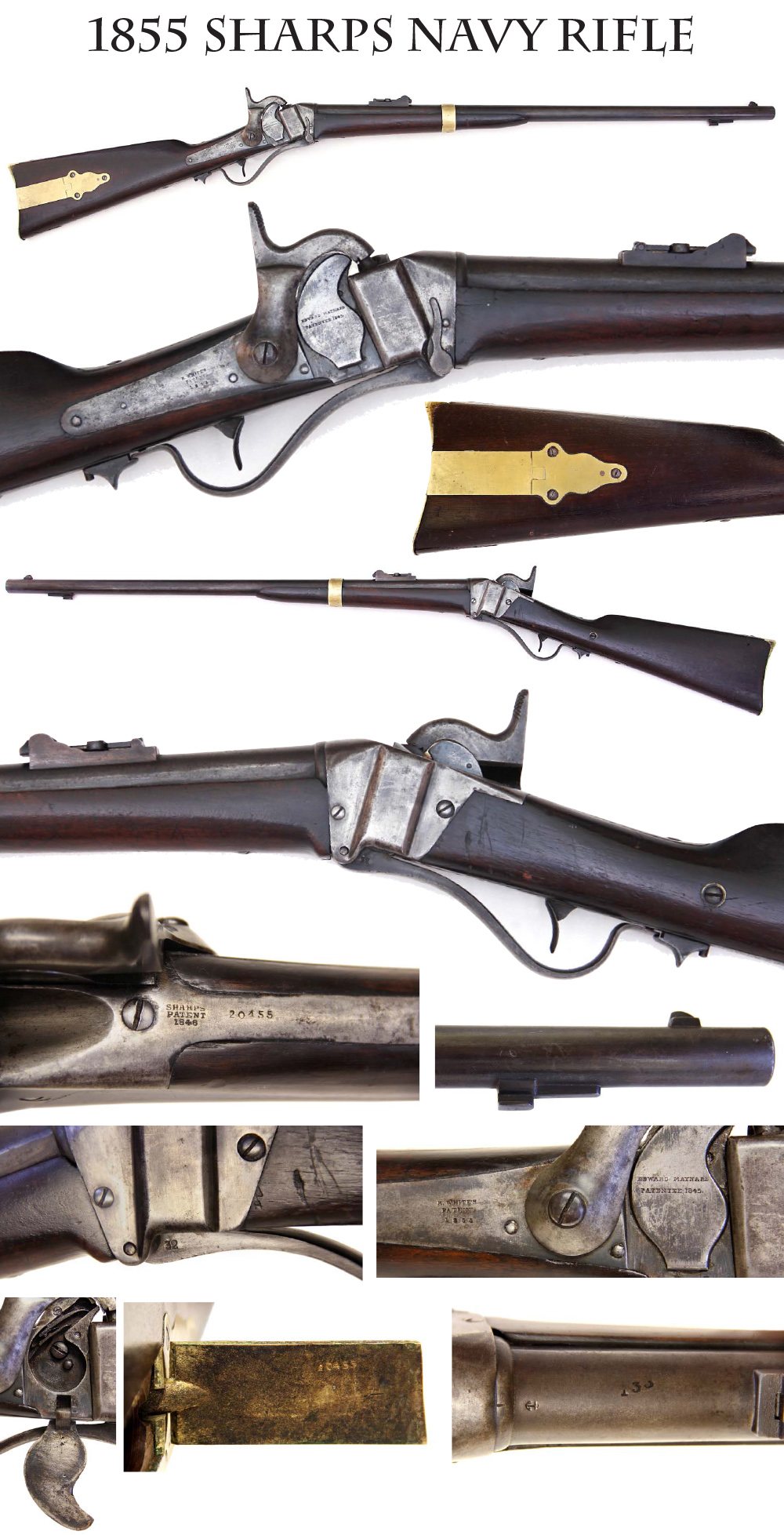
13-05-18 … This Rare 1855 Sharps Navy Rifle
“came and went” in a matter of days… I could not bring myself to waste the photos of this rarity so am showing it as one of the prizes we recently found and sold. An exceedingly rare Sharps.
Click Here to E-mail Us!
Call us @ 419-842-1863
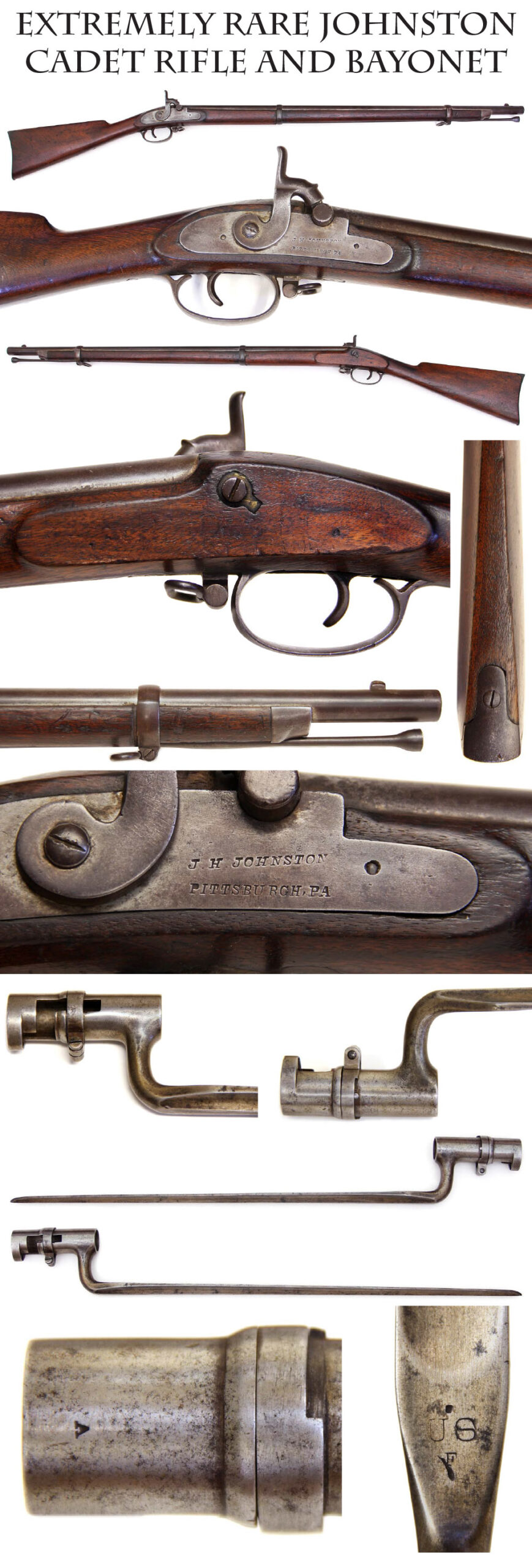
13-05-19 … Rare Pittsburgh Pennsylvania cadet rifle
made and signed by J.H. Johnston with a cadet length .58 caliber bayonet. Overall VG to fine condition. Johnston went on to operate the Great Western Gun Works in Pittsburgh and these cadet rifles were among his earliest products. Overall length roughly 47 inches, 30 inch barrel, .54 caliber rifled. Good bore. Some early collectors considered these rifles secondary martial militia weapons but their actual point of use is unknown to me. Perhaps one of you Pennsylvanians knows the answer. High quality, fine condition, and darn scarce
… $1,850.00 SOLD
Click Here to E-mail Us!
Call us @ 419-842-1863
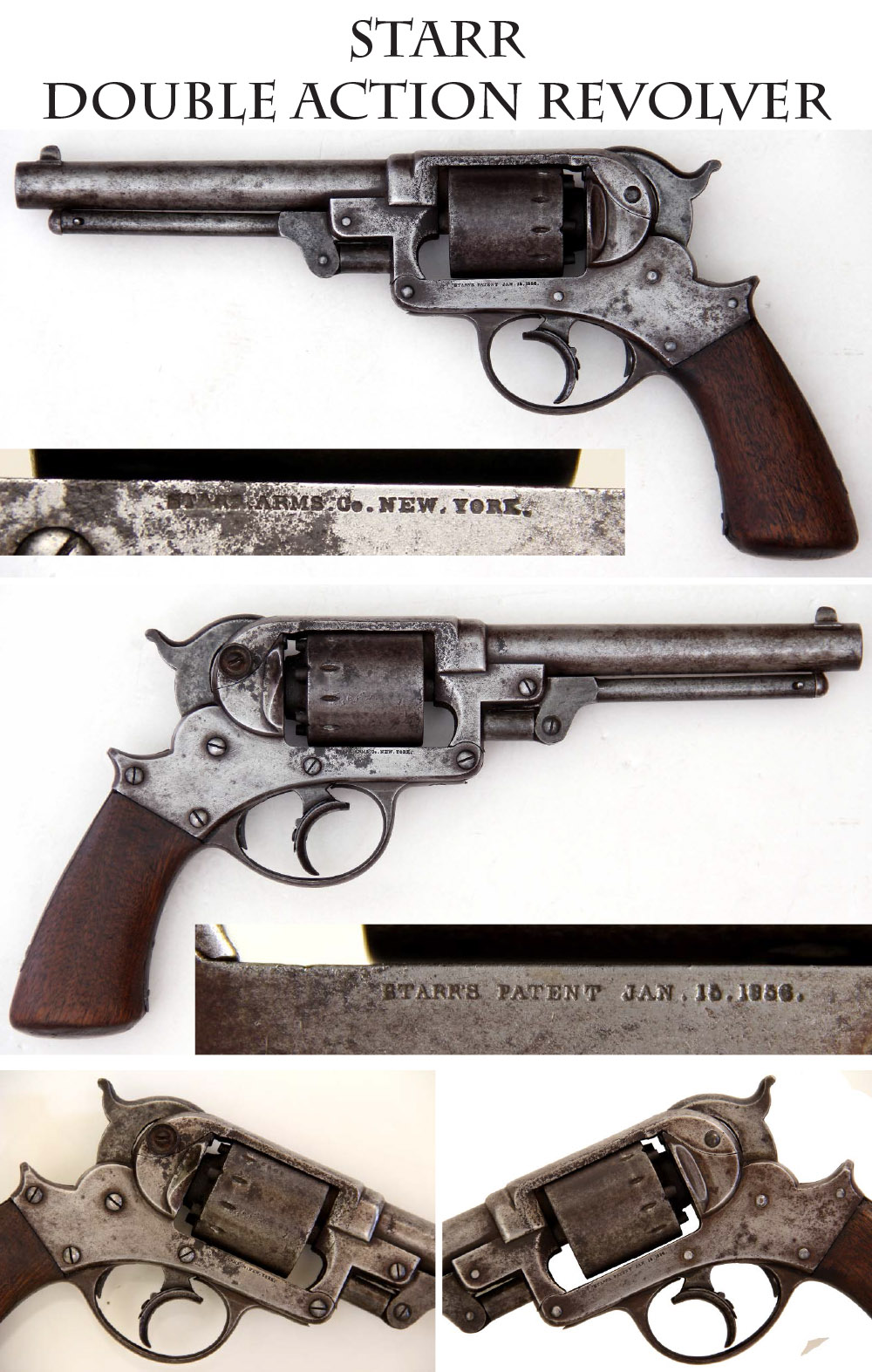
13-05-20 … Starr Revolver: Double-action 1858 Starr revolver.
About 23,000 of these .44 caliber percussion revolvers were made up to 1863 and the US government purchased most of them. I love them as examples of Victorian engineering, which could get a little too clever on occasion. The trigger rotates the cylinder and cocks the weapon and then engages a secondary trigger at rear to fire it. The trigger pressure necessary to do all that, however, could throw off a soldiers aim, and the government and the firm figured out a single action version would be cheaper, so they actually took a conscious step backwards in arms development and came out with the Starr single action revolver later. These double actions saw very wide use and are quite a gun. (It even made its way into western films: Clint Eastwood handled one in Unforgiven not too many years ago.) This one is a well used, but not abused, example. No finish remaining, but not brown or pitted. Smooth gray with dark spots overall. Good wood to metal fit on the grips. Wood shows no finish but is good, no chips or divots. Markings clear, nipples not battered down, mechanics good but sometimes gummy. A very affordable example of a gun that truly saw service in the Union Army
… $950.00
Click Here to E-mail Us!
Call us @ 419-842-1863

13-05-21 … CDV Image – Albert Sidney Johnston 2/2/1803 – 4/6/1862.
Born in Kentucky, Johnston graduated West Point in the Class of 1826, served in the 2nd US Infantry, and did staff duty in the Black Hawk War of 1832. He resigned from the army and eventually moved to Texas, where he joined the Texas army in 1836 against Mexico, serving as Aide-de-Camp to Sam Huston, eventually rising to Brigadier General and later Secretary of War of the Texas Republic. After a brief return to Kentucky he again joined the army of Texas in the Mexican War as Colonel and Inspector General of Volunteers, fighting at Monterrey and Buena Vista. Appointed Major in the US Army in 1849, he became Colonel of the new 2nd US Cavalry in 1855, and later was brevetted Brigadier General for service in the Mormon campaign of 1857. Commanding the Department of the Pacific in 1861, he resigned his commission and led a small force back to Texas to join the Confederacy. Jeff Davis gave him command of the Western Department where he was saddled with some less than competent subordinates, few men, and fewer resources. Nevertheless, after Confederate defeats at Mill Springs, Fort Henry and Fort Donelson, Johnston managed to unite with Beauregard at Corinth, Miss., in March, 1862 and led the combined army against Grant at Pittsburgh Landing, Tenn. On April 6 at the Battle of Shiloh he managed to surprise U.S. Grant the first day, but was wounded that afternoon, a bullet striking him behind the knee and severing an artery, from which he soon bled to death. Whether or not he would have won the battle, or lived up to expectations, Davis and others made his death a turning point in retrospect, regarding him as the lost hope of the lost cause. I offer several western theatre related cards on this list, including some others of Johnston. This one is a waist-up vignetted engraving based on a photograph, with a retouched double-breasted frock coat and the epaulets of a Major-General. No photographers mark, but a period pencil identification on reverse: Sidney Johnston. An affordable Confederate image
… $69.00 SOLD
Click Here to E-mail Us!
Call us @ 419-842-1863
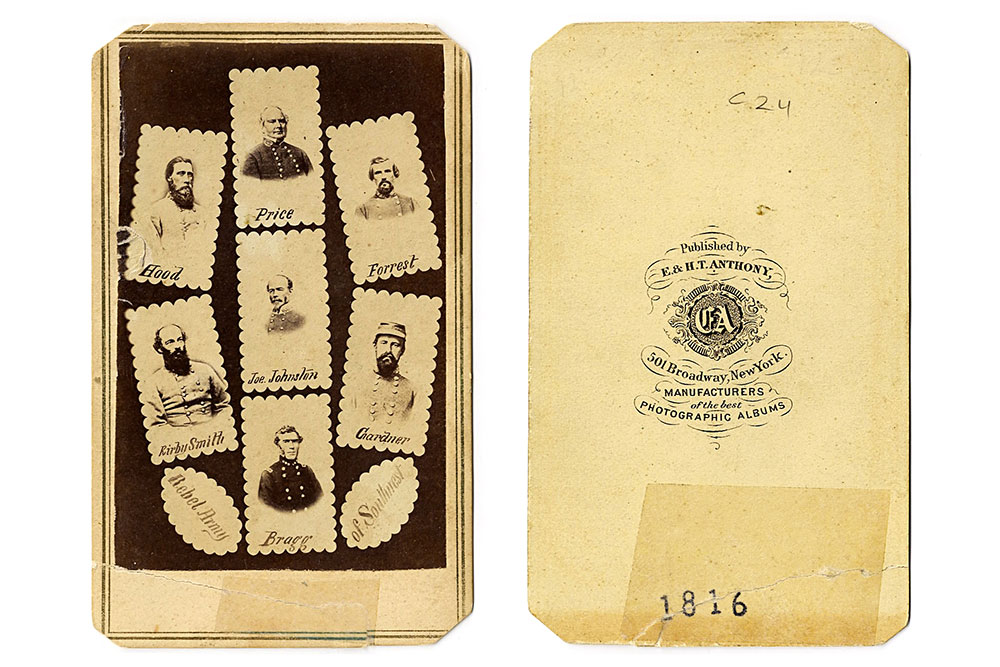
13-05-22 … Confederate CDV – Commanders of the Rebel Army of Southwest
is the caption in this composite Anthony view showing ranking rebels including the elusive N.B. Forrest who is nearly impossible to find in a wartime photograph. Joe Johnston is at center, with Hood, Price, and Forrest above, Kirby Smith and Gardner on either side, and Bragg at center below. Nice Anthony backmark. Slight crease to the albumen at center left edge, at Hoods elbow, and a break on the bottom edge of the mount repaired with tape front and back, but not affecting the albumen or images. No tax stamp as is correct for an early war view like this. A very good companion piece for some of the other western themed Confederate material I have put together here
… $125.00
Click Here to E-mail Us!
Call us @ 419-842-1863
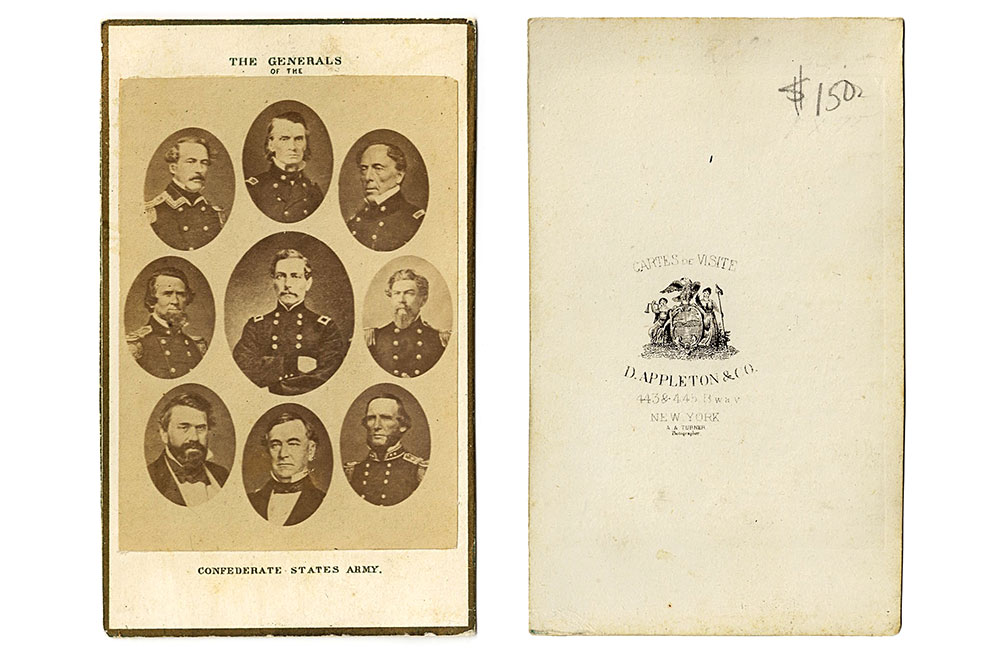
13-05-23 … CDV Confederate Generals including General Lee before he became famous!
Another early war CDV composite view. Appleton, New York, backmarked card titled on the front, The Generals of the Confederate States Army. Interestingly, this card was produced before the emergence of Robert E. Lee as the leading southern commander. P.G.T. Beauregard, instead, has center position with his defiant arms-folded pose showing off his brigadier-generals uniform. (This view of Beauregard was taken by Quinby of Charleston and is pirated here by Appleton.) Arrayed around him are the images of eight other, lesser commanders, including at upper left, Marse Robert himself. A very telling early war view showing what everyone thought would be the southern line up in the hostilities, and the men who were making the headlines at the time, while rending the nation apart.
Very fine quality photos of the 1861 military leaders
… $150.00 SOLD
Click Here to E-mail Us!
Call us @ 419-842-1863

13-05-24 … Confederate CDV –
Another view of Albert Sidney Johnston, somewhat fuller view, same retouched uniform, but waist-up showing belt, sword and sash, arm resting on a balustrade or pedestal beside him. Some slight specks from age and handling, but a good solid period card with a period pencil identification on reverse: genl. Johnston. Very nice Brady/Anthony backmark. No tax stamp, as is correct for an early war view, and lets face it,
demand lessened a bit (at least up north) after Shiloh
… $69.00 SOLD
Click Here to E-mail Us!
Call us @ 419-842-1863

13-05-25 … Confederate CDV – Lees old warhorse, General James Longstreet.
No backmark, a tad light, but a period card and likely by a southern photographer. Upper left edge sharply clipped, but not affecting the subject. Slight trimming of other corners for album insertion. A controversial figure with no small opinion of his own abilities, Longstreet was one of the major southern generals, fighting throughout the war, wounded in action, and highly regarded by many, though more successful as a Corps Commander than in independent command. He commanded troops in some of the fiercest battles of the war, and at Chickamauga it was his men who walked through a hole in the Federal line and sent Rosecrans packing.
An affordable Confederate photo
… $69.00 SOLD
Click Here to E-mail Us!
Call us @ 419-842-1863

13-05-26 … Confederate CDV – Gen. Breckinridge
reads the period pencil identification on the reverse of this Anthony backmarked CDV. Vignetted waist-up view with retouched generals frock coat. Breckinridge went south when it became clear Kentucky would stay in the Union and became commander of the Orphan Brigade, a group of Kentucky Confederate regiments orphaned by their parent state. He made Major General, but fell afoul of the ever unlikeable Braxton Bragg. Transferred to the eastern theatre, he did better, winning the Battle of New Market for instance, and was eventually appointed Secretary of War by Davis. Breckinridge was a significant figure in prewar politics: a senator, a Vice President of the US and a Confederate General. You cannot disentangle him from almost every aspect of the history of the period. This is a nice companion to the civilian view of him offered below
… $59.00 SOLD
Click Here to E-mail Us!
Call us @ 419-842-1863
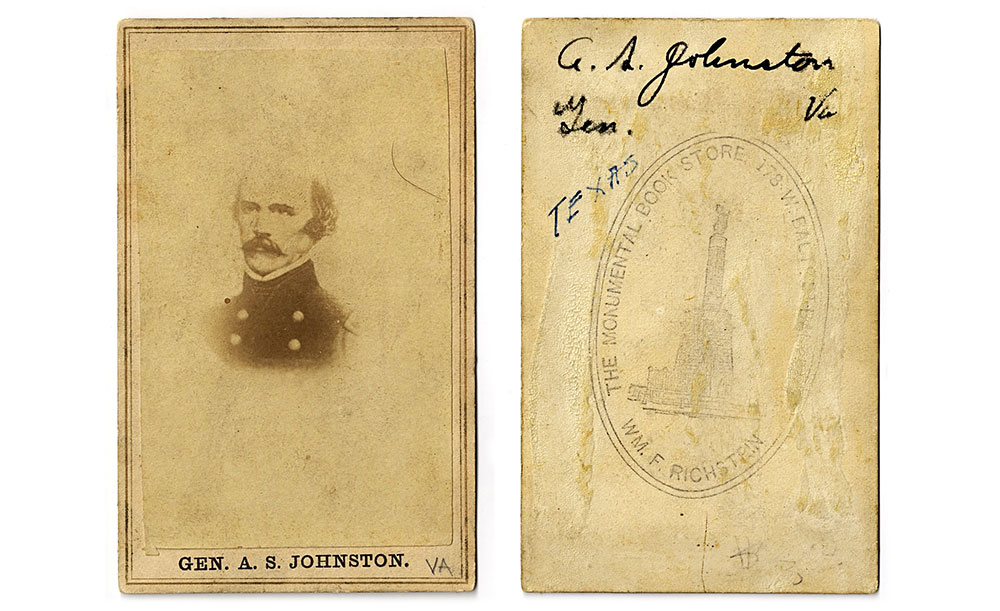
13-05-27 … Confederate CDV: A Baltimore photographers view of Gen. Albert Sidney Johnston.
I find this one interesting because of the split nature of Baltimore loyalties during the war, the card could have gone to a northerner studying the opposition or to a southern sympathizer. Gen. A.S.Johnston is the printed caption at bottom front. On reverse Wm. F. Richstein / The Monumental Book Store 178 W. Balto. St. Baltimore backmark in an oval with monument at center and the address at right partially rubbed. An old ink inscription on the reverse identifies him as A.S. Johnston / Gen. /Va. which someone corrected by writing Texas old blue ink at left. The same VA was added on the front lower margin next to the caption. Same view as others above, but a more limited mid-chest vignetted bust shot. Some surface dirt, but a good variant showing the demand for Johnstons image as the war rolled forward
… $59.00 SOLD
Click Here to E-mail Us!
Call us @ 419-842-1863

13-05-28 … Confederate CDV General A.P. Hill
This view shows even British photographers rushed to fill demand for Southern Generals. Great Britain might have come into the war on the side of the Confederacy in 1862 as a result of the Trent affair, at least the south prayed and hoped for official recognition. The working men preferred the Union, but the upper crust had an affection for the chivalry of the south. Here photographer C.B. Walker in Bayswater tries to meet the demand. General Ambrose Powell Hill is handsomely portrayed in a richly contrasted waist-up portrait. His uniform is retouched, but the facial features are very sharp. Lt. Gen. AP Hill is written at bottom front over an older pencil identification. Small spot to lower left of arm. Pencil identification on reverse. Minor tape stains on reverse and inventory number stamp. Oval spot of foxing left margin, not touching albumen. Hills record will be familiar- a corps commander under Lee, he was a tough fighter and killed in action at Petersburg just days before the war in Virginia ended
… $150.00 SOLD
Click Here to E-mail Us!
Call us @ 419-842-1863
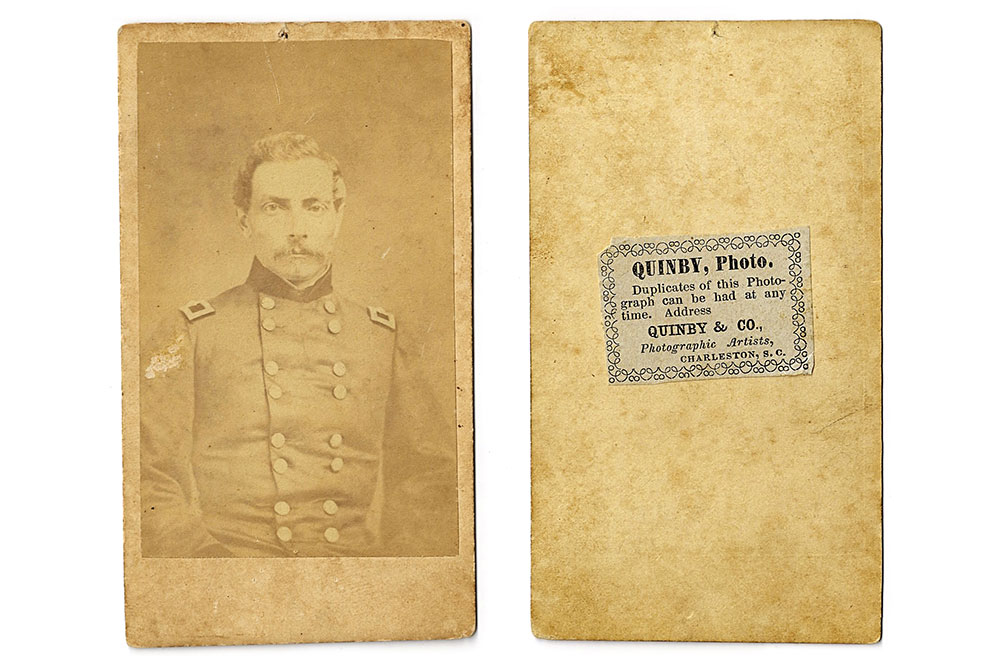
13-05-29 … Rare CSA Photo – Very scarce Charleston, South Carolina backmarked CDV of General Pierre G.T. Beauregard.
Seated waist-up view of Beauregard in his Brigadier Generals uniform. Slight rub to his right arm near margin. Pasted photographer label on reverse: Quinby, Photo. Duplicates of this Photography can be had at any time. Address Quinby & Co., Photographic Artists, Charleston, S.C. The view is a tad light, but is a from life view when Beauregard was assigned to the command of the defenses of Charleston during the crisis at Fort Sumter. Quinby took several pictures of Beauregard the day he opened fire on Sumter. He was later victorious at Bull Run and went to the western theatre where he served with Albert Sidney Johnston and later took command there before returning to supervise the defense of Charleston. His poor relations with Jefferson Davis hindered his career, but he was active in keeping Petersburg out of Federal hands and was eventually given command again in the west, though only after Hood had destroyed the army, and he was eventually superseded by Joe Johnston. Beauregard was a West Point grad from Louisiana, went into the Engineers, which was the upper crust of the army, and served in Mexico, receiving both wounds and brevets, as Captain and Major. After the war, bored with peacetime duties, he at one point considered resigning from the army and joining Walkers filibustering expedition to Nicaragua in the 1850s, but fortunately did not, since Walker ended up in front of a firing squad. At the beginning of the war he became the first Confederate Brigadier General and the uniform in this photo shows it was taken before the full regulations for Confederate uniforms could take effect and before he acquired the CS generals frock coat in which he usually appears.
A nice early war and significant card with the Confederate photogaphers label on the reverse. Truly significant
… $395.00 SOLD
Click Here to E-mail Us!
Call us @ 419-842-1863
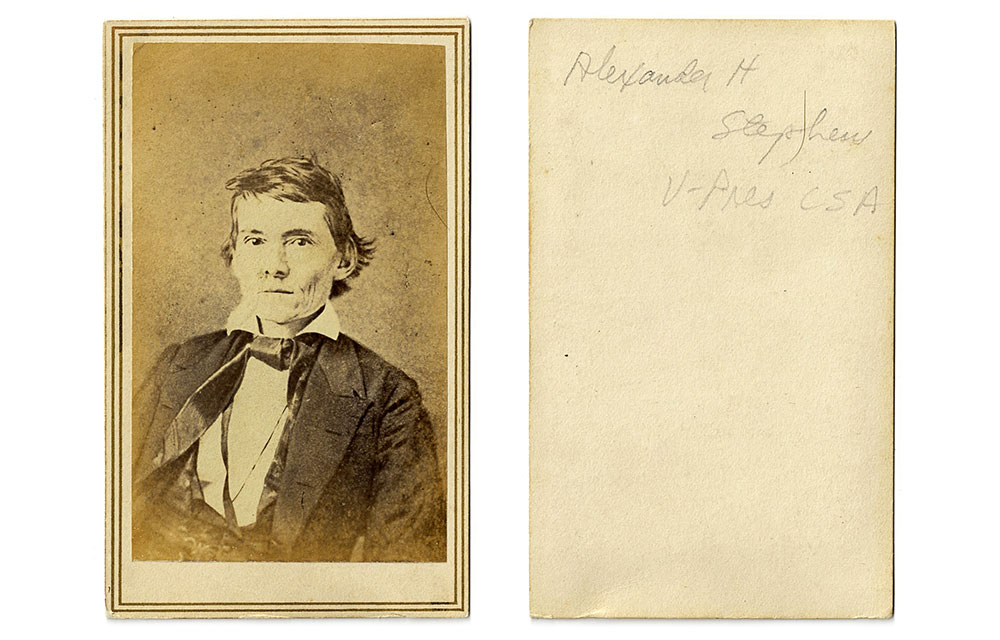
13-05-30 … Scarce Confederate CDV CSA Vice President Alexander H. Stephens.
Pencil identification on reverse with pencil addition in a different hand V-Pres CSA. Alexander Hamilton Stephens, 1812-1883, was a US Representative from Georgia both before and after the war, Governor of the state 1882-83, and Vice President of the Confederate States of America during the war. A prewar lawyer and politician, who once suffered a knife attack by a political opponent, Stephens opposed secession on practical grounds, but was firm in his support of slavery. During the war he was frequently at odds with Jefferson Davis on issues such as conscription and suspension of habeas corpus. In early 1865 he was one of three Confederate peace commissioners sent to meet Lincoln in a meeting lately made famous in Spielbergs movie Lincoln, where it looked very like Spielberg had gotten Stephens to play himself. This card has no backmark appears to be an 1863 era pirate photo and very likely pirated in the South. A very strong image with much appeal. Quite scarce
… $195.00
Click Here to E-mail Us!
Call us @ 419-842-1863
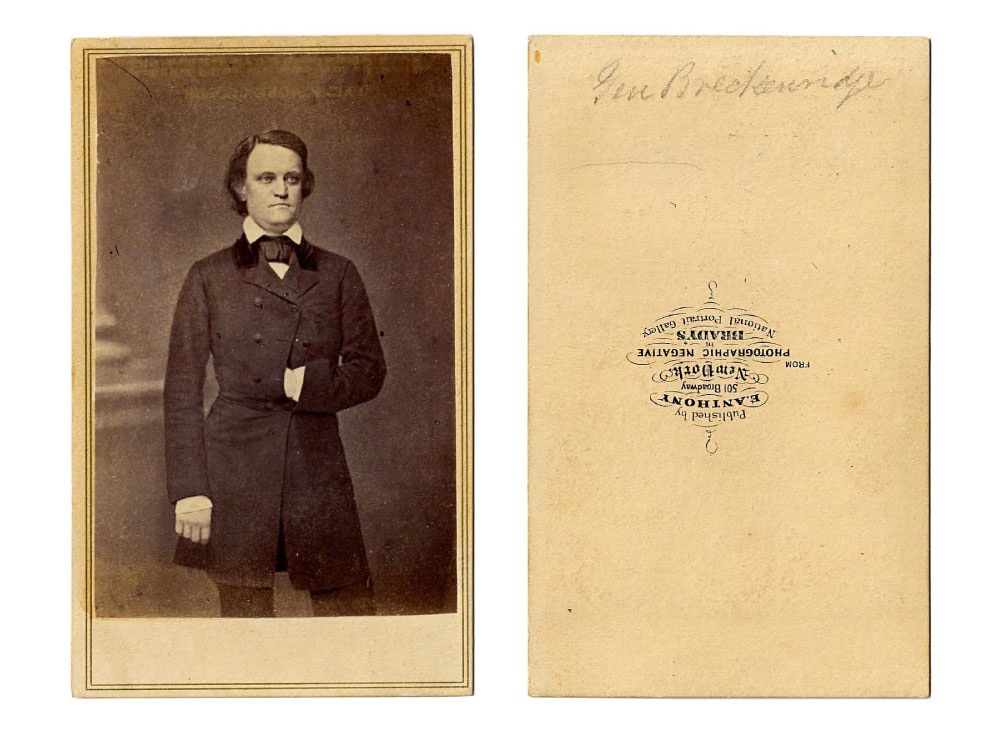
13-05-31 …
Confederate CDV – Breckinridge of Kentucky as Politician and Statesman. Three-quarter standing view by Brady/Anthony, with their backmark. Old pencil id on reverse: Gen. Breckenridge. John Cabell Breckinridge, 1821-1875, was both Representative and Senator from Kentucky, Vice President under Buchanan, and a presidential candidate in 1860 against both Douglas and Lincoln. His background was as a lawyer and politician, with brief service in the Mexican War as Major of late war Kentucky regiment. He was deeply involved in the prewar debates on slavery, its expansion, states rights, and secession. He fled to the Confederacy after Kentuckys neutrality was breached and it went for the Union, and he was formally expelled from the US Senate as a traitor. After military service in both the western and eastern theatres of war, and attaining the rank of Major General, Davis appointed him CS Secretary of War. Realistic about Confederate chances toward the end, he acted to ensure the preservation of Confederate records and managed to escape to Britain, Europe, and Canada until he returned to the US under a general amnesty in 1868. Nice Brady photo … $125.00
Click Here to E-mail Us!
Call us @ 419-842-1863

13-05-32 … Confederate CDV – From- Life, Alabama Confederate Colonel.
Vignetted bust view taken by H.A. Olwell of Mobile, Alabama. Some light foxing spots, and a tad light as most southern cdvs are due to shortages of photographic chemicals, slight wear spots on left edge of albumen, not touching figure. A true from-life Confederate CDV of a Confederate officer and by a Confederate photographer. Our subject is a bearded rebel clearly showing on his collar the three stars of a full Colonel. Good resolution and clarity on the face. Upper two left buttons of his coat visible. Coat itself light and fading, buttons and collar stars were slightly tinted. A little research might develop an identification. As a field grade officer he must have been a significant figure in the community. Southern officers images are scarce. When they are on southern backmarked cards they are downright rare
… $195.00 SOLD
Click Here to E-mail Us!
Call us @ 419-842-1863

13-05-33 … Two CDV Photos of a Mississippi Confederate. These two images are of John H. Mosby, 41st and 9th Mississippi,
wounded in action at New Hope Church. The first view is a fine crisp bust portrait of the young Confederate wearing a CSA infantrymans jacket the photo card bearing a Mobile, Alabama photographers back mark. A very fine CSA military image from-life. Next image is of the same man also from life, posed in citizens garb, nicely signed in pencil on the reverse: Your Aff Nephew Jno. H. Mosby and then noted in ink: Taken April 17th 1864. J.W. Turner, Meridan, Miss., backmark. Records show our J.H. Mosby enlisted 2/20/62 at Meridian, Mississippi, in company that became Co. G of the 41st. He initially enlisted for twelve months, then for three years on 4/14/62, as the Confederate terms of service were changed, and eventually for the war. The regiment served in Andersons and Browns brigades in the Army of the Mississippi and Army of the Tennessee, then Chalmers and Andersons. It saw action at Shiloh, Murfreesboro, Chickamauga, Missionary Ridge, Resaca, Atlanta, and elsewhere. Mosbys compiled service record shows that he was wounded in action at New Hope Church 6/22/64 and sent to hospital, but returned to duty. Toward the end of the war the regiment was consolidated with several other Mississippi regiments and redesignated the 9th Mississippi, Mosbys company becoming Co. H. Mosby rose during his service from Corporal to 4th Sergeant, and was with them at the end, being paroled 5/1/65 at Greensboro. In regard to the image of Mosby in citizens garb we might expect Mosby to be in uniform for a photo taken April 17, 1864, and we might ask why he was home to do it. A note in his compiled service record gives an explanation: Absent 25 days under General Order 227 from April 10, 1864. This is a very nice tie-in covering the date of the photo- he was home on leave and got dressed up in civilian clothes for a formal portrait for the family. Identified yankee cdvs are a dime a dozen by comparison. Here are two from – life views of a real combat veteran Johnny Reb infantryman
… $695.00 SOLD
Click Here to E-mail Us!
Call us @ 419-842-1863

13-05-34 … War of 1812 Eagle Head Sword:
Beautiful Eagle Pommel Officers Saber with an Honour and my Country etched blade. A horsemans length curved blade in the form often called the 1796 light cavalry, after its British counterpart. Super condition with bluing on the upper third of the blade to set off the engraved and gilt-highlighted motifs. One side has the motto below a trophy of arms- crossed cannons and flags surmounted by a liberty cap on a pole. Below the motto a floral motif that is probably a combination of olive branch and laurel wreath forming a crown of victory. The opposite side has a smaller trophy of arms with a wonderful Federal style American eagle with 15 stars overhead and a ribband reading E Pluribus Unum, topped by victory wreath and a sunburst. On either side there is further engraved and gilt geometric and floral motifs under half-round langets. The gilding is strong and the blue is vivid. The eagle pommel with backstrap surmounts a checkered bone grip. A chain knuckle guard connects the eagles beak to the straight cross guard that terminates in a scroll quillon.
The langets are semicircular with a fan motif of a half globe surrounded by a spray of elongated buds resembling a rising sun with rounded rays. Grips are very good, no cracks, just some very minor ticks and chips to the top edges under the backstrap from shrinkage and a slight discoloration just under the pommel. Blade shows gray mixed with dark spots on the lower unblued portion, one darkish area near the tip, but no pitting. Blue very nice with some plum brown visible underneath. No scabbard, but these were usually leather and broken or lost over the years. A really super sword from the early years of the Republic with a great patriotic motto, a bold eagle in gold on the blade set off by the blue, and another impressive eagle on the pommel. This is a great looking sword and really quite a good value for something that is two hundred years old and still retains such beauty
… $1,395.00 SOLD
Click Here to E-mail Us!
Call us @ 419-842-1863
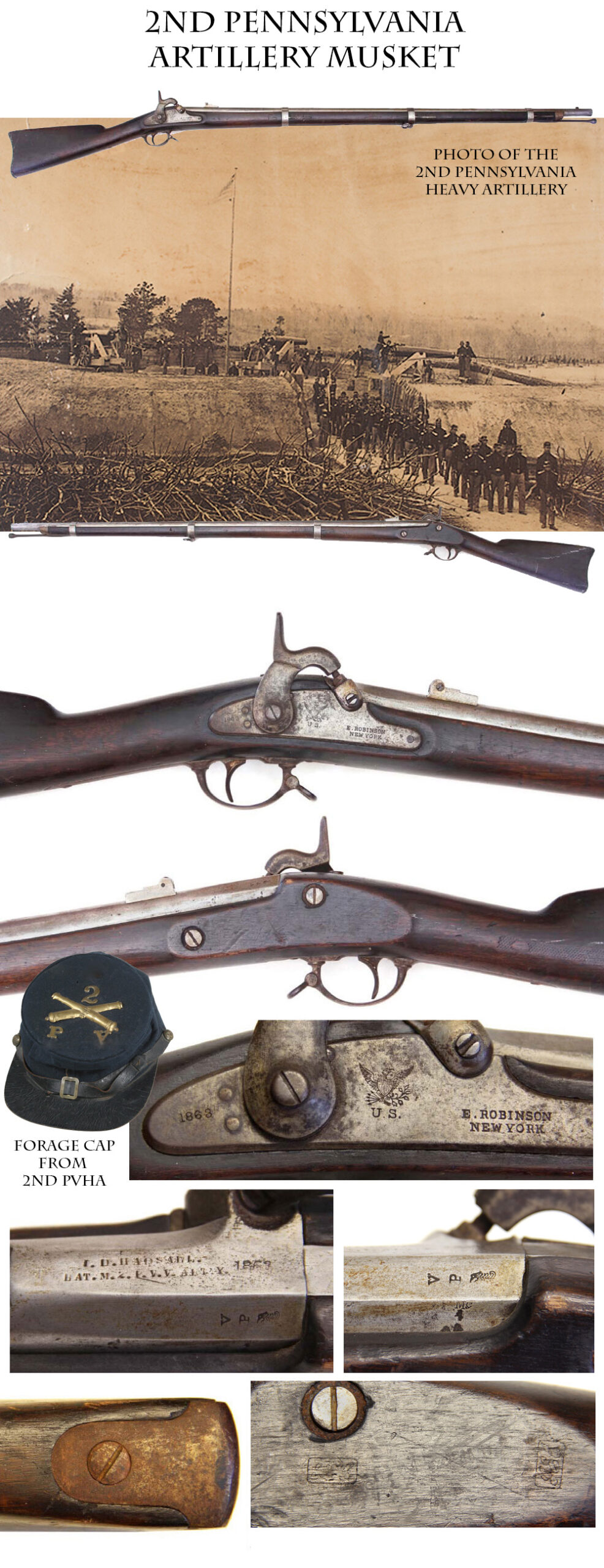
13-05-35 … Identified Pennsylvania Soldiers Rifle – Wilderness and Petersburg!
A very good condition 1863 Robinson Contract 1861 pattern rifle musket with a legitimate id to a soldier in the Second Pennsylvania Heavy Artillery, one of those units who thought they would be kicking back in the DC forts, but got called to the front as Infantry by Grant in 1864. I have seen a few guns over the years with similar dead-real markings- done very neatly with small dies on the flat of the barrel near the breach, something the soldier very likely paid to have done for him. This one reads: I.D. Hadsall / Bat. M. 2. P.V.V. Arty. Isaac D. Hadsall enlisted in the 2nd Pa Heavy Artillery 11/11/1863 and mustered into Company M the same day. He was mustered out 1/29/66 at City Point, Virginia. This is a nice condition gun. Barrel and bands faded bright, smooth metal with some graying. Lockplate showing more gray, mostly behind the hammer, but with very clear date, eagle over US, and E. Robinson / New York on the lockplate, with the Robinson name in a straight line, as is correct for guns made under his June, 1863, contract. Good mechanics, ramrod, swivels and sights in place. Slightly rounded edges to wood from handling, but still pretty sharp- both cartouches are visible on the off-side.
Good nipple and clean-out screw. Matching barrel date. Clear V/P/eagle proofs on left barrel flat.
The Second PA Heavy Artillery was an interesting regiment. Called into the field in 1864 to act as infantry, it was a large regiment and had received so many new recruits that in April, 1864, it was divided into two regiments, one consisting of the newer men being sent off to the 9th Corps, where it fought at Spottsylvania and Cold Harbor, and the other going to the 18th Corps with whom it fought at Petersburg, and where the two regiments were again united and consolidated. It seems that Hadsall, being one of the newer recruits and in company M was one those who fought in the Wilderness Campaign with the 9th Corps in addition to serving at Petersburg. He saw some serious action. The regiment was large, and took a large number of casualties, losing 5 officers and 221 enlistedmen killed or mortally wounded during its service in the field. Hadsall may have marked his gun while in the field, but he could also have done so before going home: soldiers were permitted to purchase their arms and accoutrements at the end of the war (one way for the government to reduce inventory and raise some cash) and his service records show that he did indeed purchase this musket when he was mustered out!
One of the better identified muskets I have owned
… $2,850.00 SOLD
Click Here to E-mail Us!
Call us @ 419-842-1863
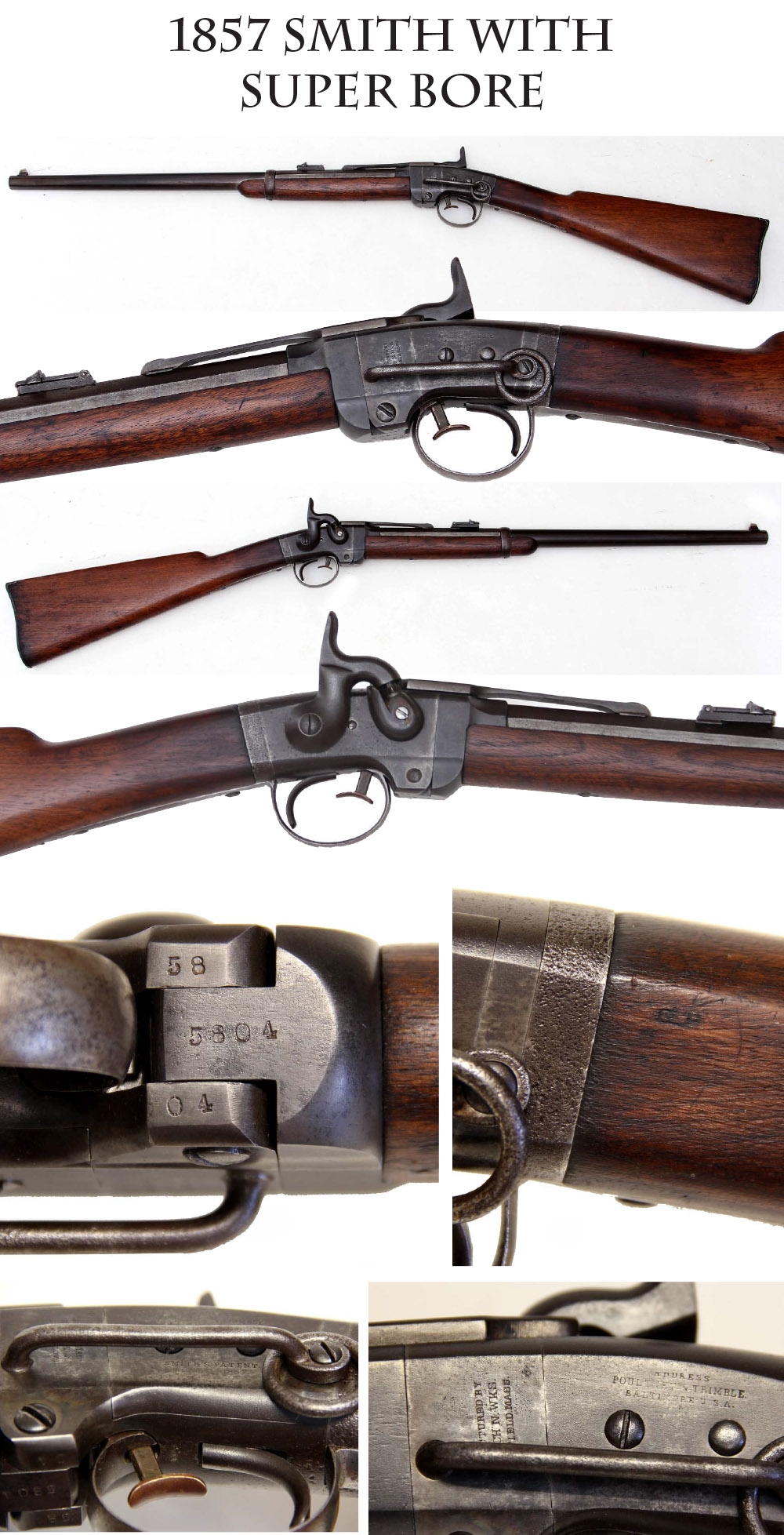
13-05-36 … Smith Carbine with a Super Bore!
Matching serial number 5804, sights, sling bar and ring in place. Good, tight action, and outstanding bore. Flayderman often says the bore should be disregarded, but with the Smith and Maynard carbines collectors value the bores highly. This one is super. As with the example offered above, this was a popular cavalry arm used by a number of units with extensive service, and fired a .50 caliber foil or hard-rubber cased cartridge. This example shows clean wood, light brown in tone, darker toward the wrist, faint cartouche, no significant dings, good wood-to-metal fit. Metal generally smooth, the band at the wrist shows salt-and-pepper pitting. Barrel gray mixed with faded plum. Forward portion of breech shows mellowing blue. Receiver a mottled bluish-gray with faint traces of case color. Bright clean-out screw on the bolster is probably a replacement. A good example of one the many arms carried by Yankee troopers in all theatres throughout the war. Those cavalrymen massacred at the Platt Bridge Station by Sioux in Wyoming even carried Smiths!
A good tight example
… $1,595.00 SOLD
Click Here to E-mail Us!
Call us @ 419-842-1863
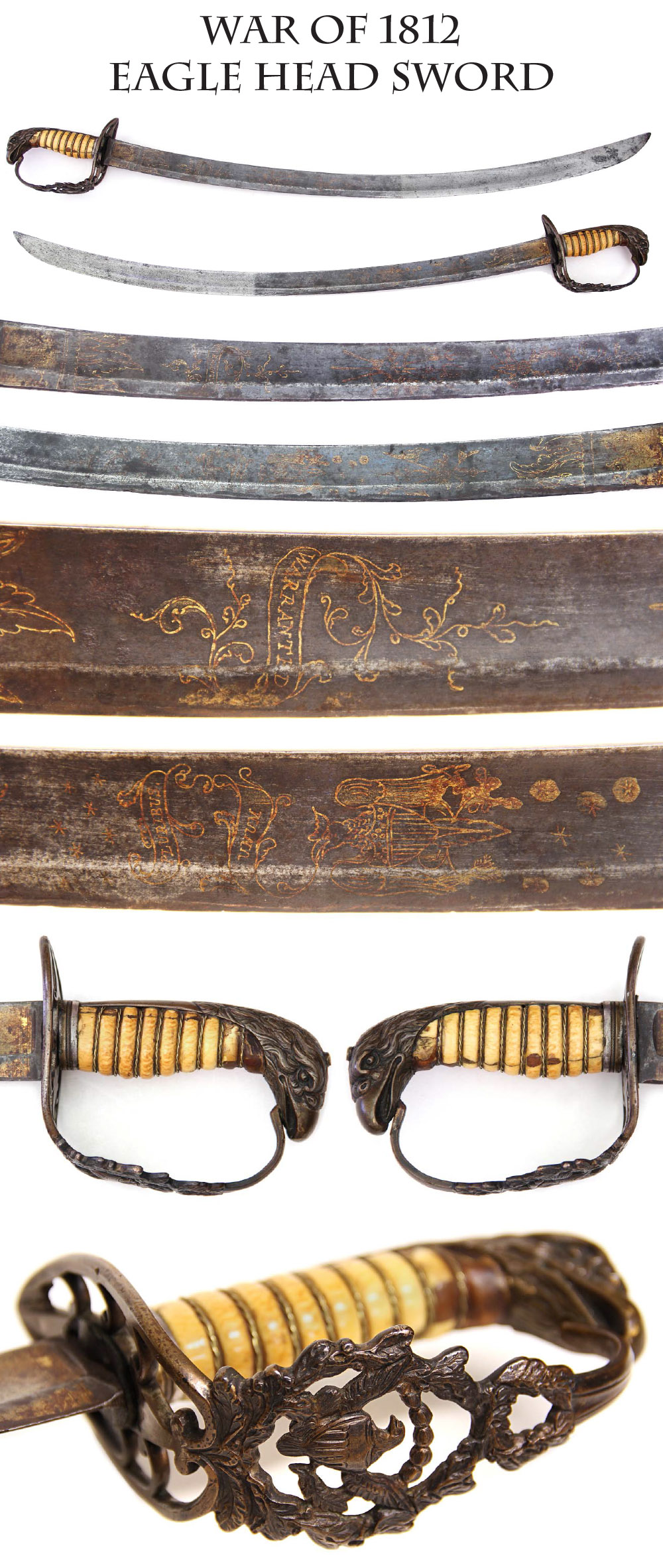
13-05-37 … An 1812 Saber with Three Eagles!
A wonderful War of 1812 period eagle pommel sword, but with an eagle on the pommel, the blade, and in the guard to boot. No scabbard, of course, but a horsemans length blade, blued for about half its length, the bottom half a gray mixed with dark spots, the blue faded to a light blue and a light purple in places. Engraved and gilded floral designs on both sides, somewhat rubbed, but visible. One side with a makers guarantee Warranted in a ribband, the other with a nice American eagle with a shield on its breast, stars top and bottom, and a ribband with E Pluribus Unum. Beautiful and ferocious Eagle pommel with yellow bone or ivory grooved grip with twisted wire running in the grooves. Slight horizontal crack and some dark areas in the bone at the ends. Perhaps the neatest thing is the wonderful openwork guard. Open slots on the counterguard with curved bars are reminiscent of the Revolutionary War era, the knucklebow opens out into a very well done spread-winged eagle with a US shield on its breast surrounded by a wreath and topped with an arc of clouds, and above that is another small victory wreath. Really attractive and striking. It looks like some traces of silver wash here and there, which would be appropriate both for an officer in the infantry and in the dragoons. A top notch 200 year old American patriotic sword
… $1,650.00
Click Here to E-mail Us!
Call us @ 419-842-1863
Layaways are Welcome
Need to split your order into multiple payments? No problem! A simple 20% earnest money deposit will hold your item for you.-acf
You can then pay it off in easy installments that fit your budget.
Read Terms Here
Items to Sell? Contact Us
I am always interested in buying ANYTHING from the American Civil War… Guns, Swords, Civil War Muskets, Knives, Uniforms, Flags, Medals, Badges, Diaries, Letters, Autographs, Buttons, photographs, tintypes, daguerreotypes, Insignia, Camp Items, Battlefield Relics, canteens, Drums, Etc… Call 419-842-1863 and ask for Dave Taylor.

